The document covers various data structures in programming, particularly focusing on structures, unions, and self-referential structures. It details array operations, including declaration, initialization, manipulation, and common algorithms for sorting and accessing elements. Additionally, it explains the interaction of arrays and functions in programming, emphasizing the difference between passing arrays by reference and elements by value.
![CHAPTER 2 1 Structures (records) struct { char name[10]; int age; float salary; } person; strcpy(person.name, “james”); person.age=10; person.salary=35000;](https://image.slidesharecdn.com/dsmodule-12023-240707035514-c76abc94/75/Basics-of-Data-structure-using-C-describing-basics-concepts-1-2048.jpg)
![CHAPTER 2 2 Create structure data type typedef struct human_being { char name[10]; int age; float salary; }; or typedef struct { char name[10]; int age; float salary } human_being; human_being person1, person2;](https://image.slidesharecdn.com/dsmodule-12023-240707035514-c76abc94/75/Basics-of-Data-structure-using-C-describing-basics-concepts-2-2048.jpg)
![CHAPTER 2 3 Unions Similar to struct, but only one field is active. Example: Add fields for male and female. typedef struct sex_type { enum tag_field {female, male} sex; union { int children; int beard; } u; }; typedef struct human_being { char name[10]; int age; float salary; date dob; sex_type sex_info; } human_being person1, person2; person1.sex_info.sex=male; person1.sex_info.u.beard=FALSE;](https://image.slidesharecdn.com/dsmodule-12023-240707035514-c76abc94/75/Basics-of-Data-structure-using-C-describing-basics-concepts-3-2048.jpg)
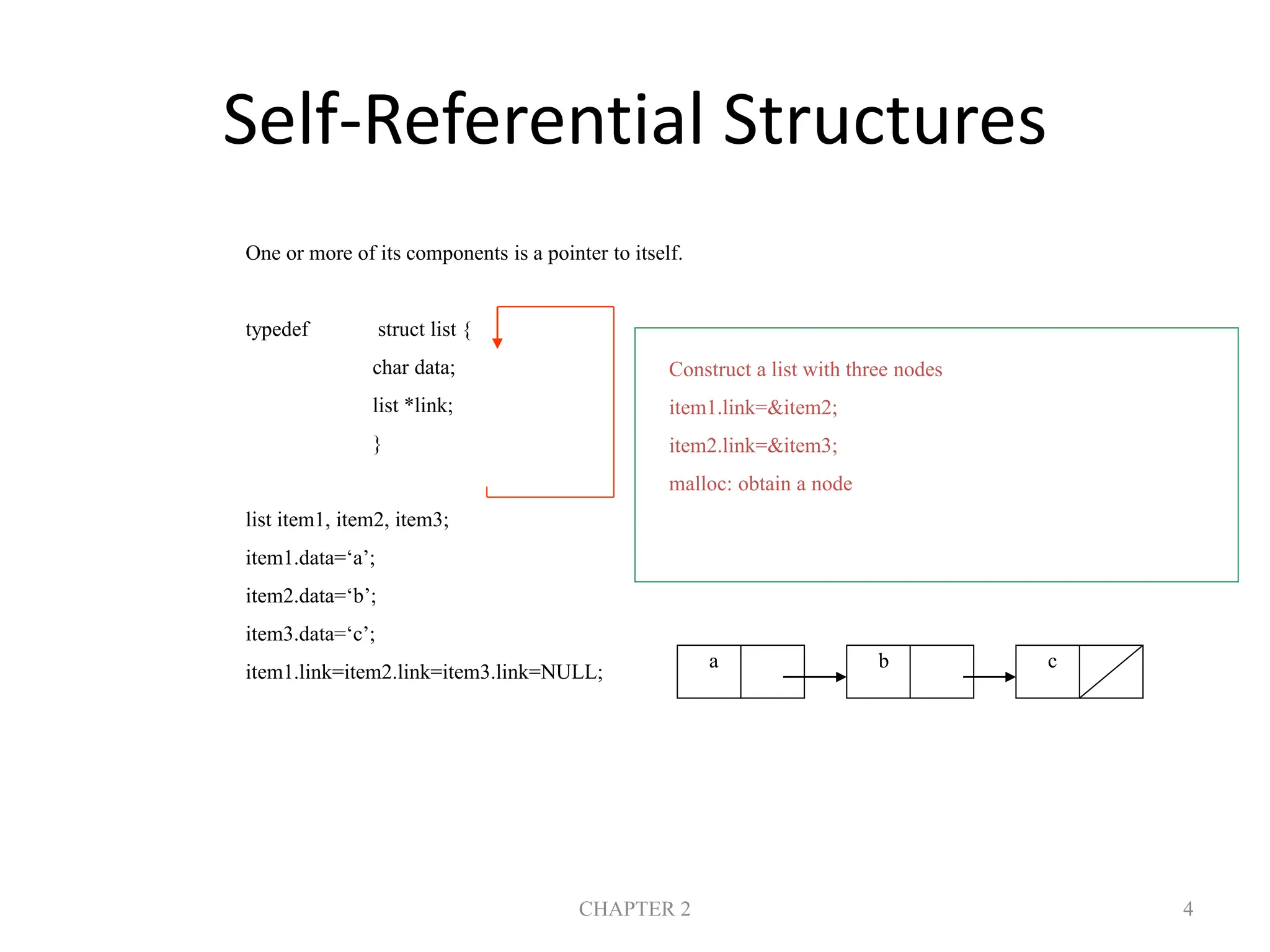
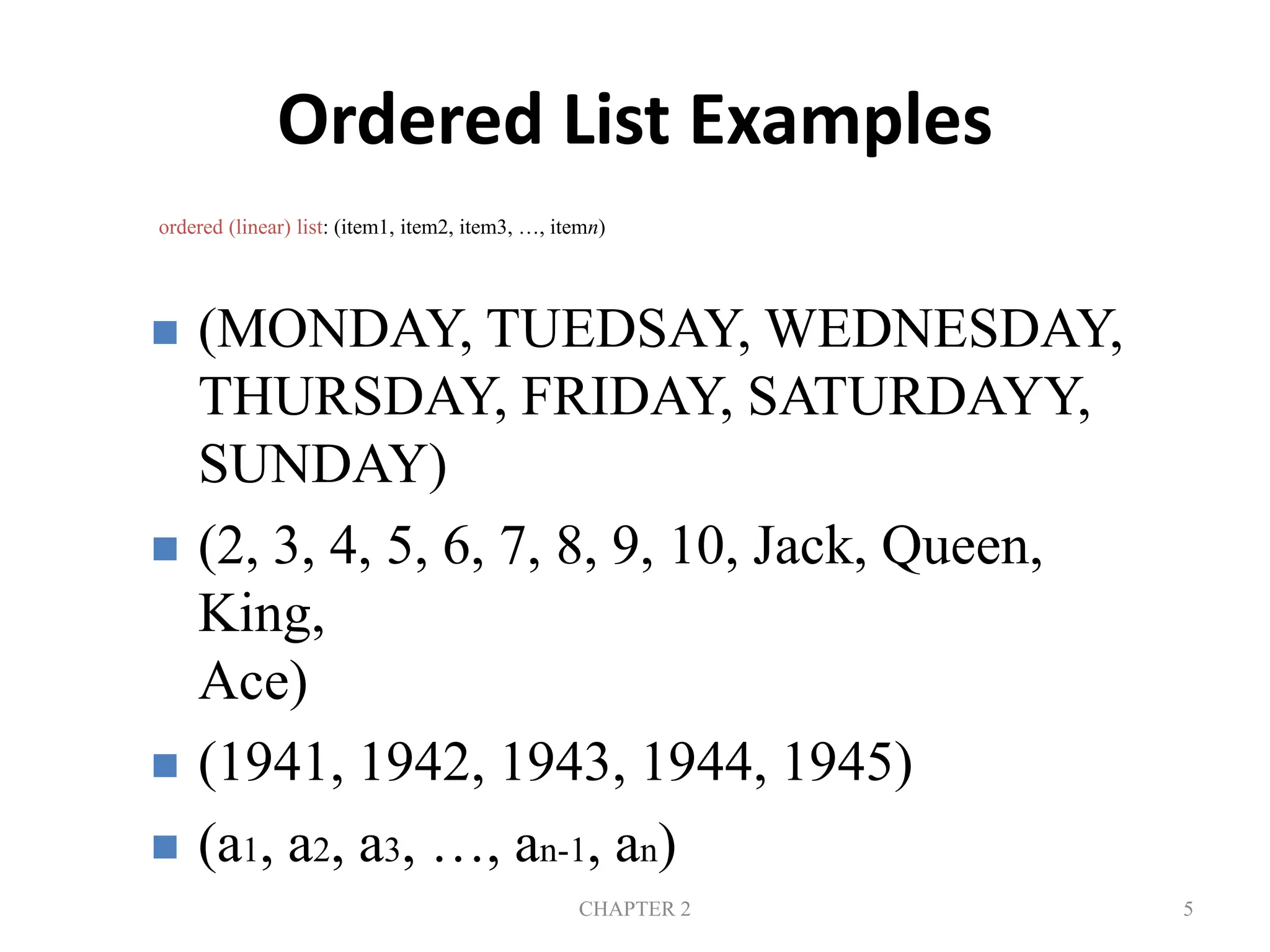
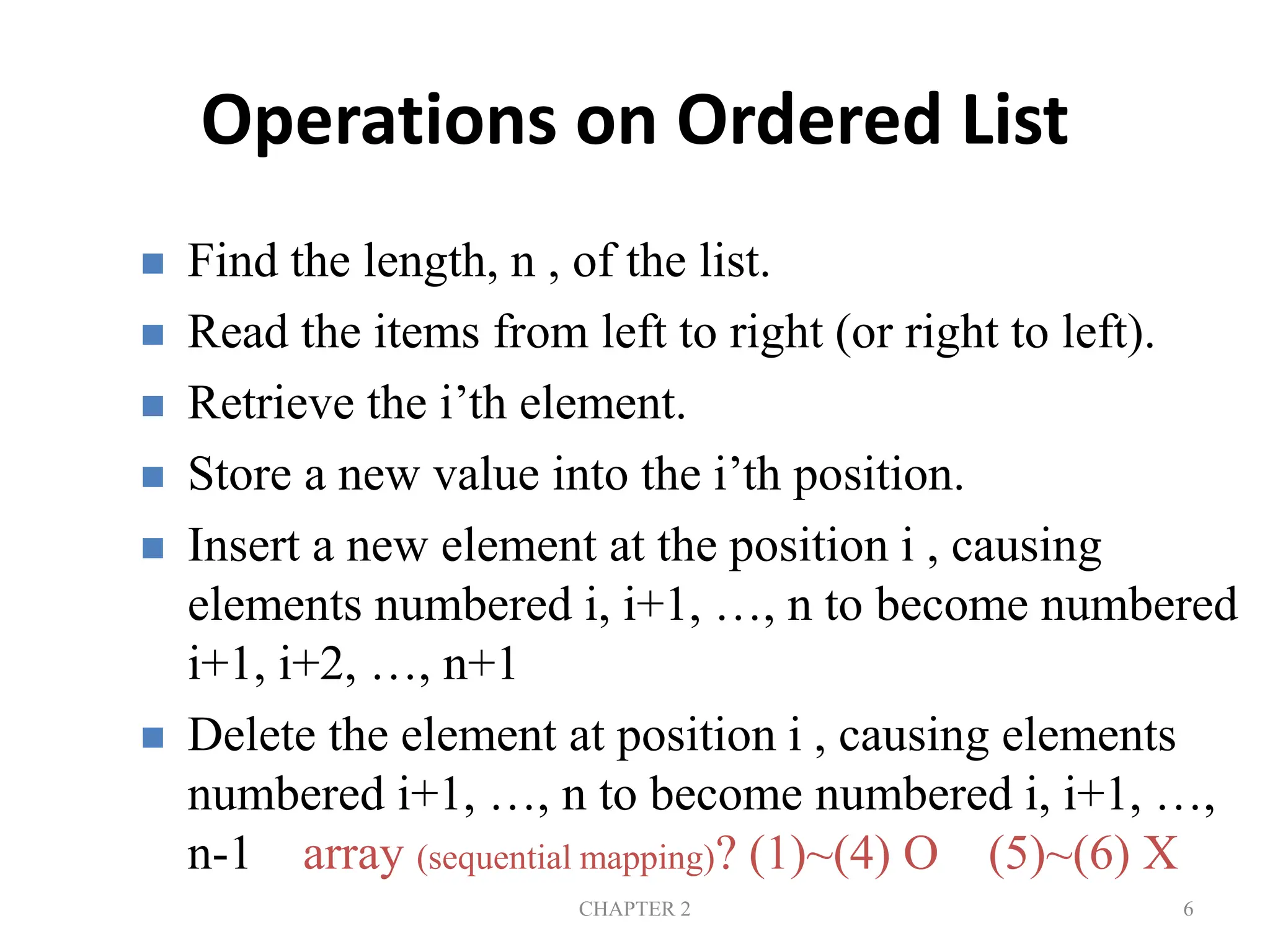
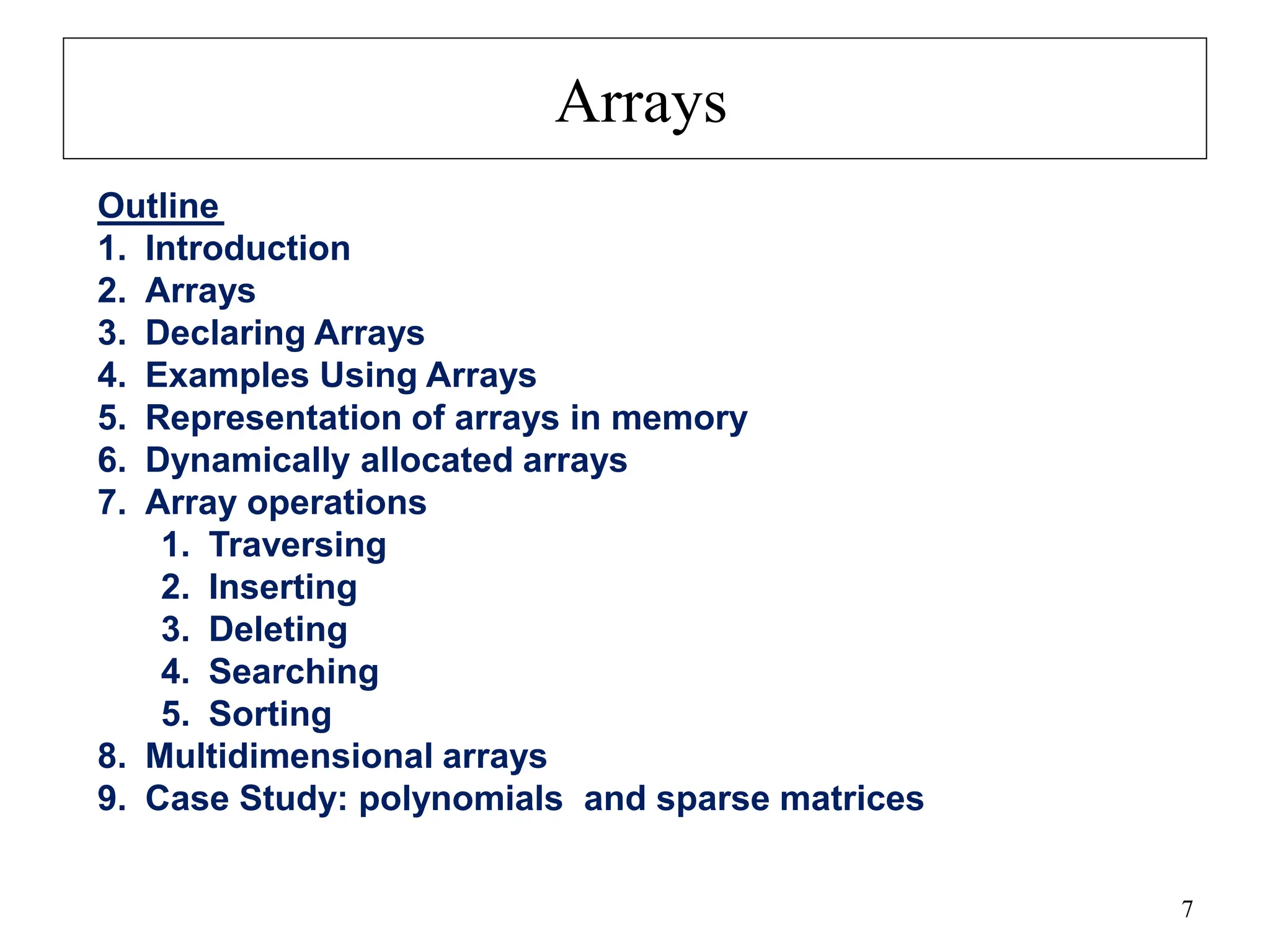
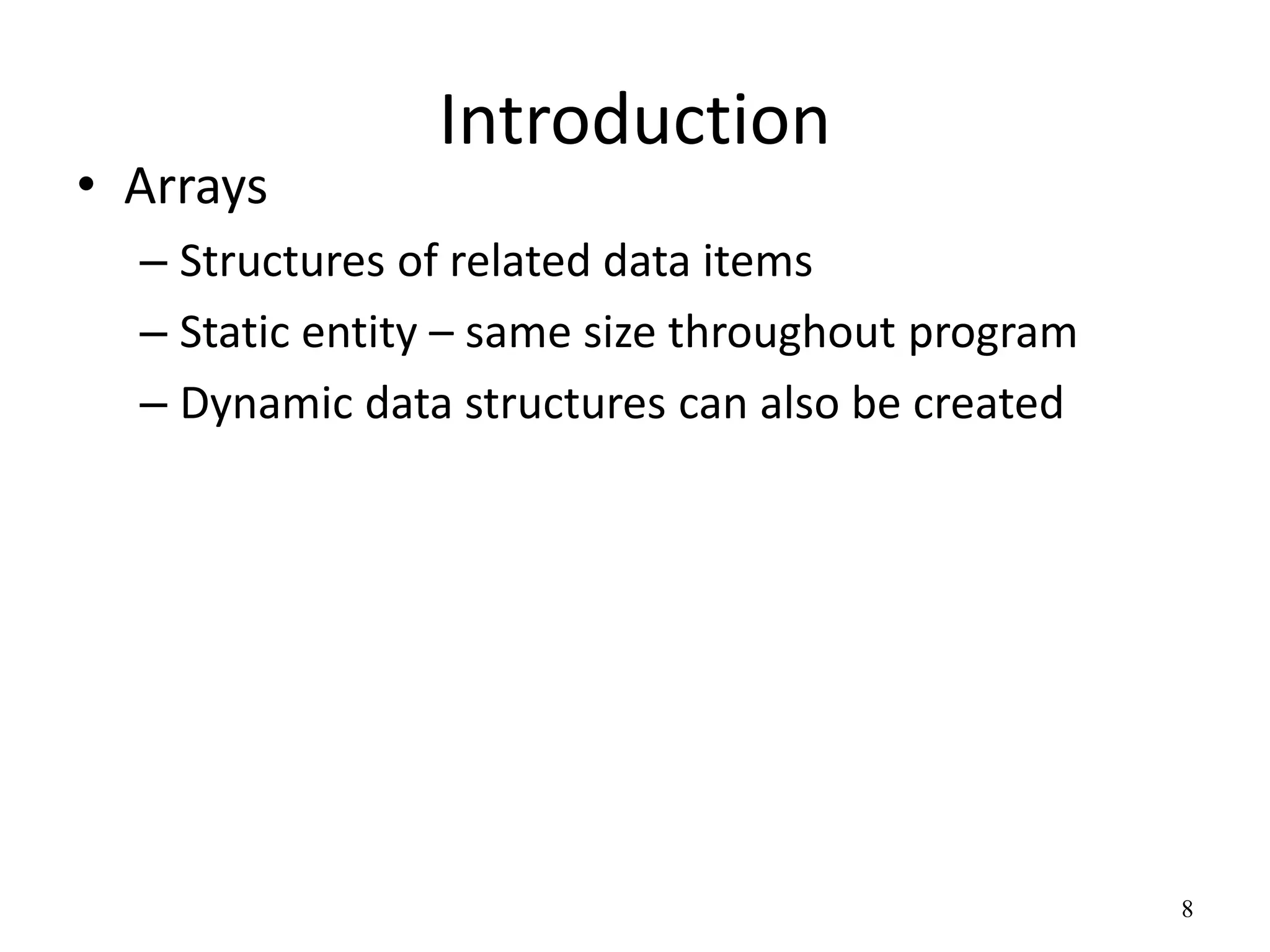
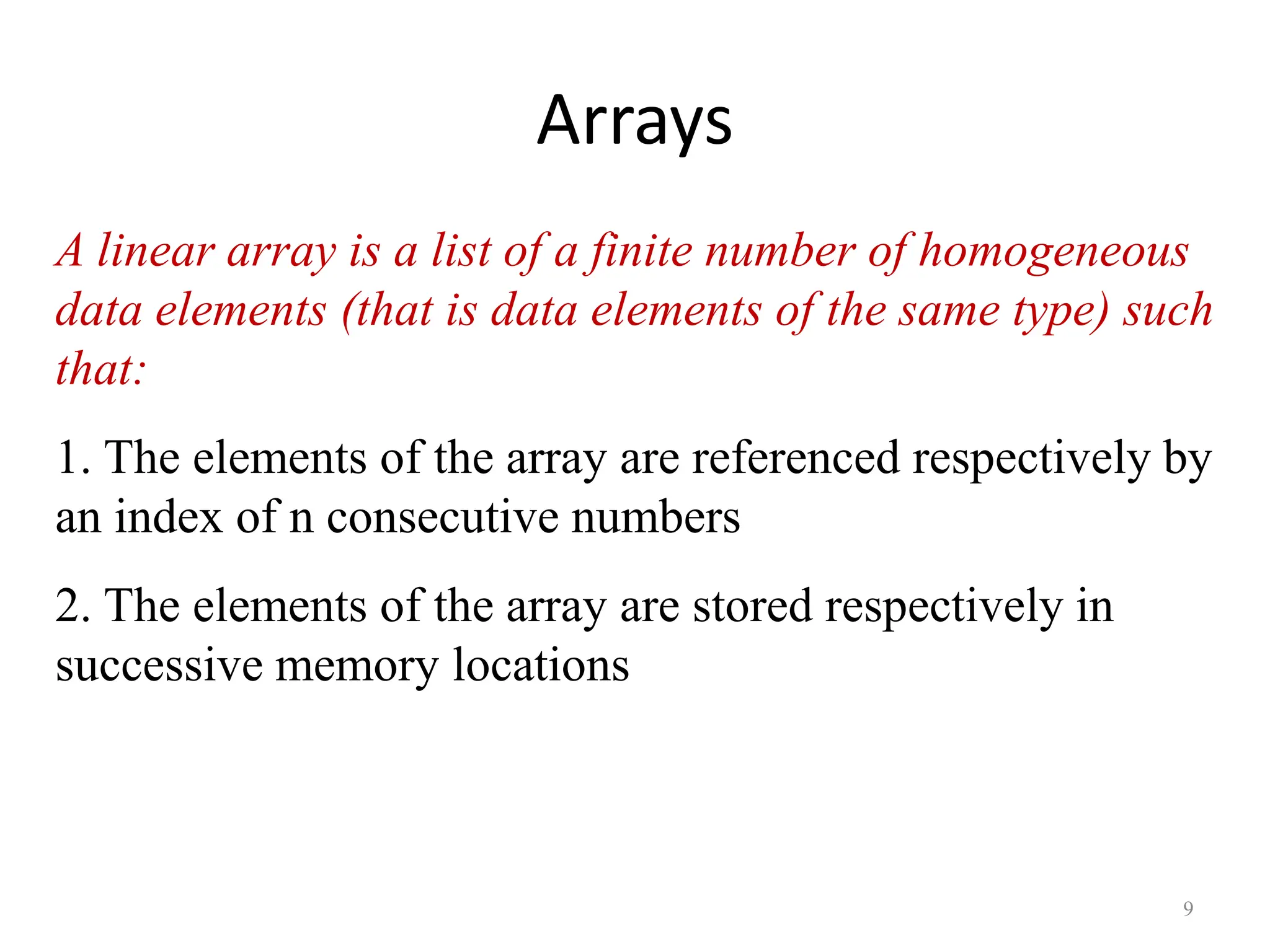
![Arrays • Array – Group of consecutive memory locations – Same name and type • To refer to an element, specify – Array name – Position number • Format: arrayname[ position number ] – First element at position 0 – n element array named c: • c[ 0 ], c[ 1 ]...c[ n – 1 ] 10 Name of array (Note that all elements of this array have the same name, c) Position number of the element within array c c[6] -45 6 0 72 1543 -89 0 62 -3 1 6453 78 c[0] c[1] c[2] c[3] c[11] c[10] c[9] c[8] c[7] c[5] c[4]](https://image.slidesharecdn.com/dsmodule-12023-240707035514-c76abc94/75/Basics-of-Data-structure-using-C-describing-basics-concepts-10-2048.jpg)
![Arrays • Array elements are like normal variables c[ 0 ] = 3; printf( "%d", c[ 0 ] ); – Perform operations in subscript. If x equals 3 c[ 5 - 2 ] == c[ 3 ] == c[ x ] 11](https://image.slidesharecdn.com/dsmodule-12023-240707035514-c76abc94/75/Basics-of-Data-structure-using-C-describing-basics-concepts-11-2048.jpg)
![Declaring Arrays • When declaring arrays, specify – Type – Name – Number of elements arrayType arrayName[ numberOfElements ]; – Examples: int c[ 10 ]; float myArray[ 3284 ]; • Declaring multiple arrays of same type – Format similar to regular variables – Example: int b[ 100 ], x[ 27 ]; 12](https://image.slidesharecdn.com/dsmodule-12023-240707035514-c76abc94/75/Basics-of-Data-structure-using-C-describing-basics-concepts-12-2048.jpg)
![Examples Using Arrays • Initializers int n[ 5 ] = { 1, 2, 3, 4, 5 }; – If not enough initializers, rightmost elements become 0 int n[ 5 ] = { 0 } • All elements 0 – If too many a syntax error – C arrays have no bounds checking • If size omitted, initializers determine it int n[ ] = { 1, 2, 3, 4, 5 }; – 5 initializers, therefore 5 element array 13](https://image.slidesharecdn.com/dsmodule-12023-240707035514-c76abc94/75/Basics-of-Data-structure-using-C-describing-basics-concepts-13-2048.jpg)
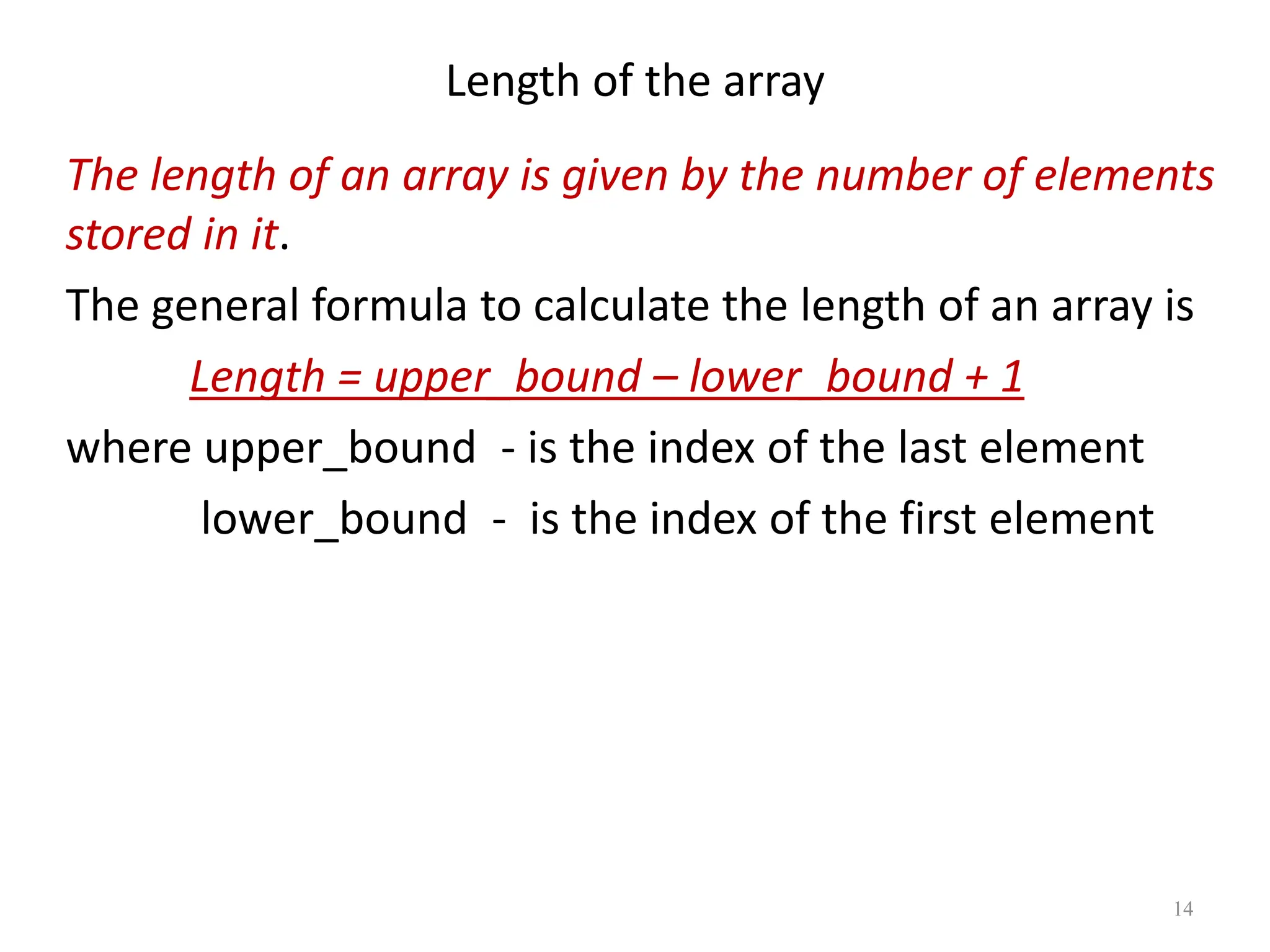
![15 Ex: Let Age[5] be an array of integers such that Age[0] = 2, Age[1] = 5, Age[2] = 3, Age[3] = 1, Age[4] = 7 Show the memory representation of the array and calculate its length.](https://image.slidesharecdn.com/dsmodule-12023-240707035514-c76abc94/75/Basics-of-Data-structure-using-C-describing-basics-concepts-15-2048.jpg)
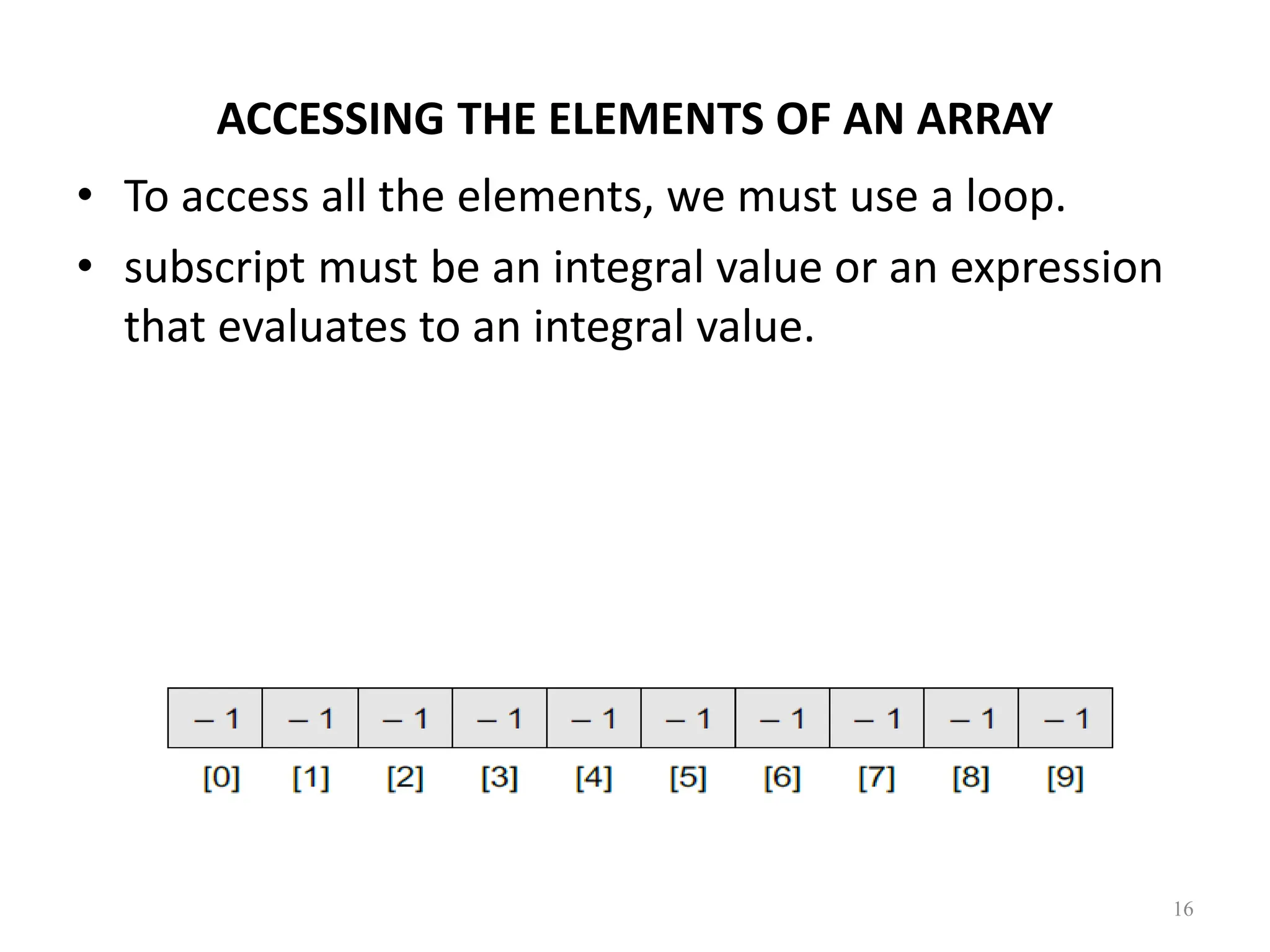
![Calculating the Address of an Array Elements 17 Address of data element, A[k] = BA(A) + w(k – lower_bound) A -is the array K - is the index of the element of which we have to calculate the address, BA – is the base address of the array A, w - is the size of one element in memory, Ex: size of int is 2. Given an array int marks[] = {99,67,78,56,88,90,34,85}, calculate the address of marks[4] if the base address = 1000. marks[4] = 1000 + 2(4 – 0) = 1000 + 2(4) = 1008](https://image.slidesharecdn.com/dsmodule-12023-240707035514-c76abc94/75/Basics-of-Data-structure-using-C-describing-basics-concepts-17-2048.jpg)
![Example-2 calculating address An automobile company uses an array AUTO to record the number of auto-mobiles sold each year from 1932 to 1984. suppose Auto appears in memory at location 200 and w=4 words. Find the address of the array element for year k=1965 18 The address of the array element for the year k=1965 can be obtained : Loc(Auto[1932]) = Base (Auto)+w (1965 - lower bound) = 200 + 4 (1965-1932)= 332](https://image.slidesharecdn.com/dsmodule-12023-240707035514-c76abc94/75/Basics-of-Data-structure-using-C-describing-basics-concepts-18-2048.jpg)
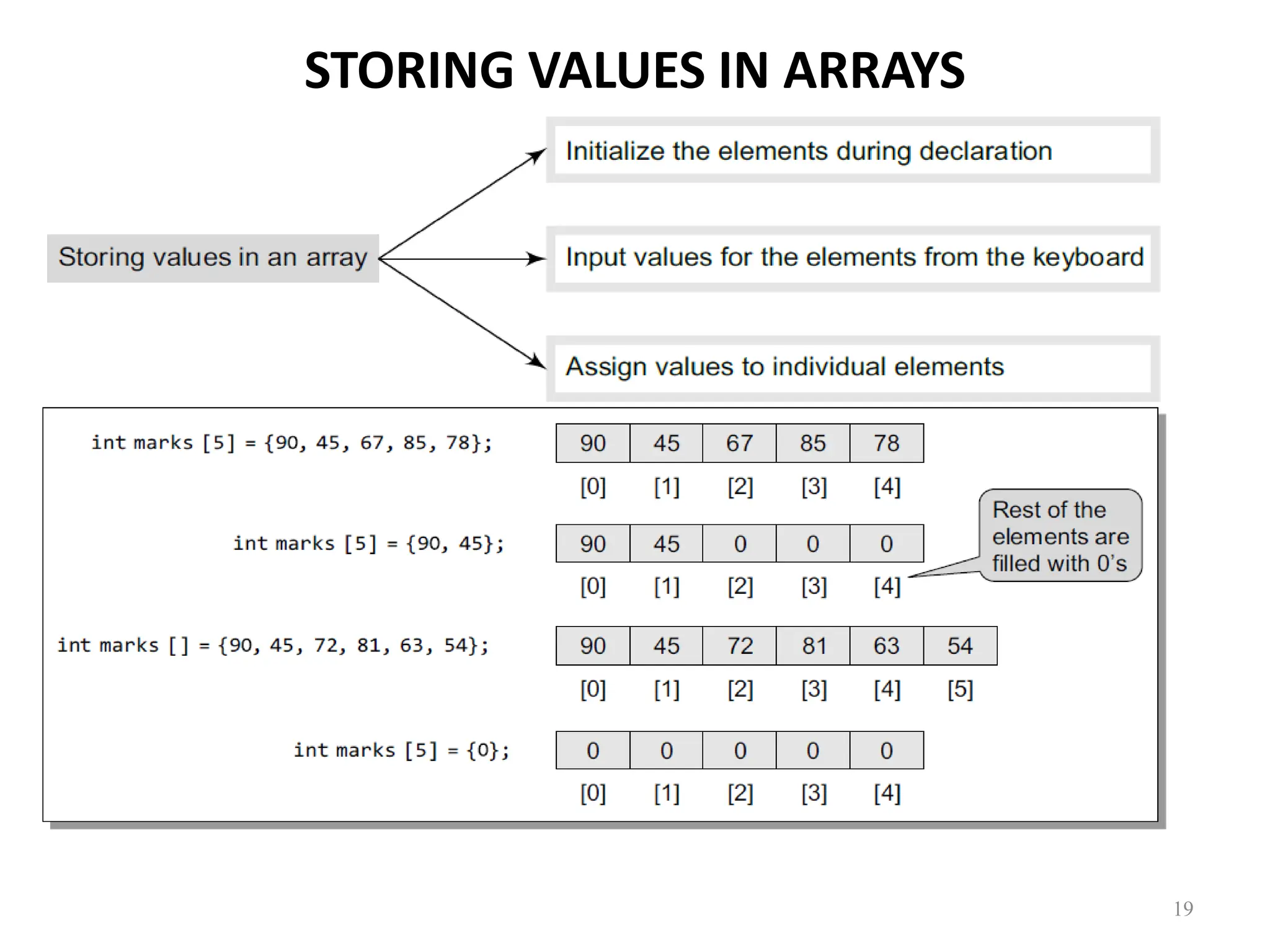
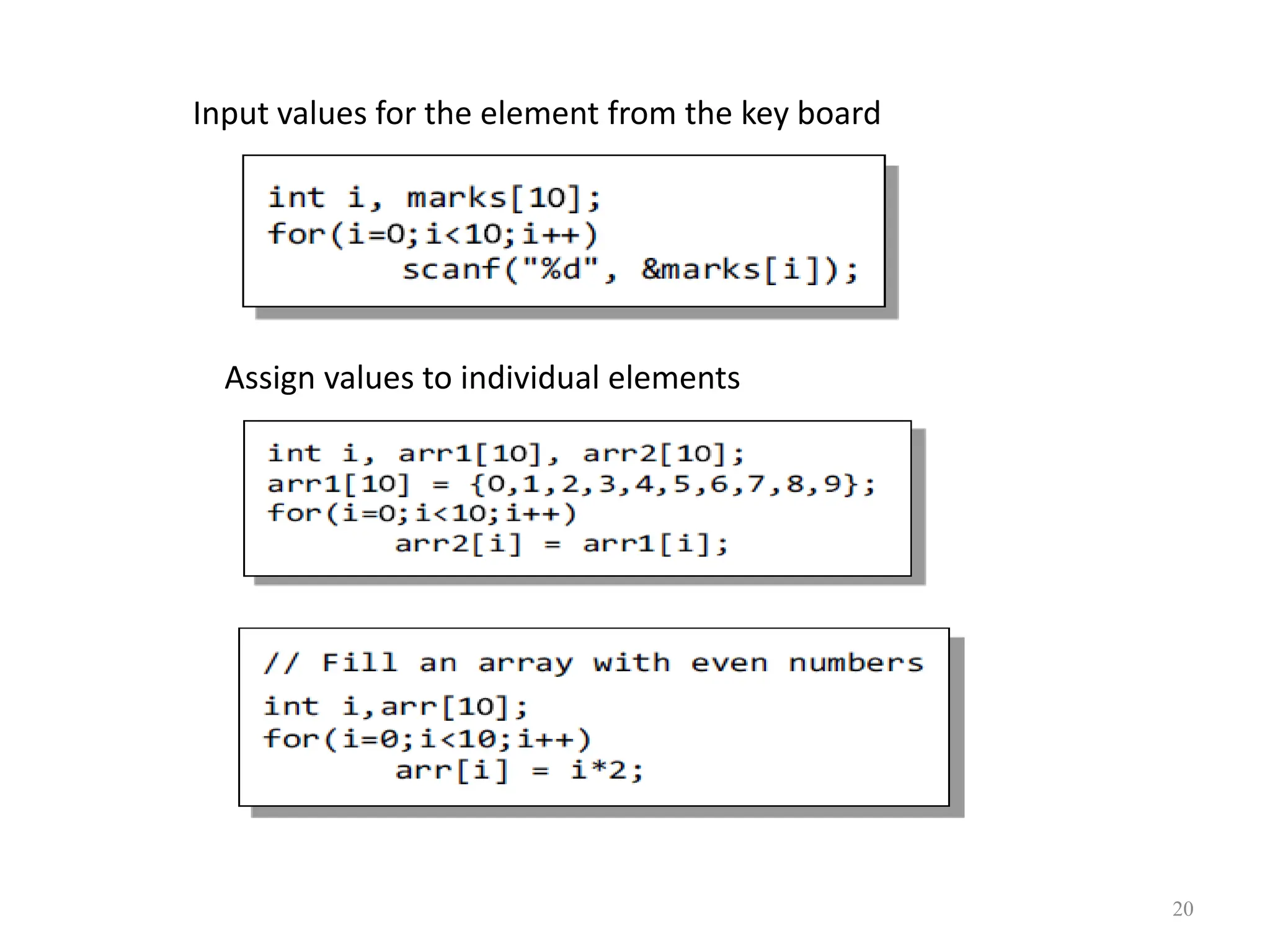
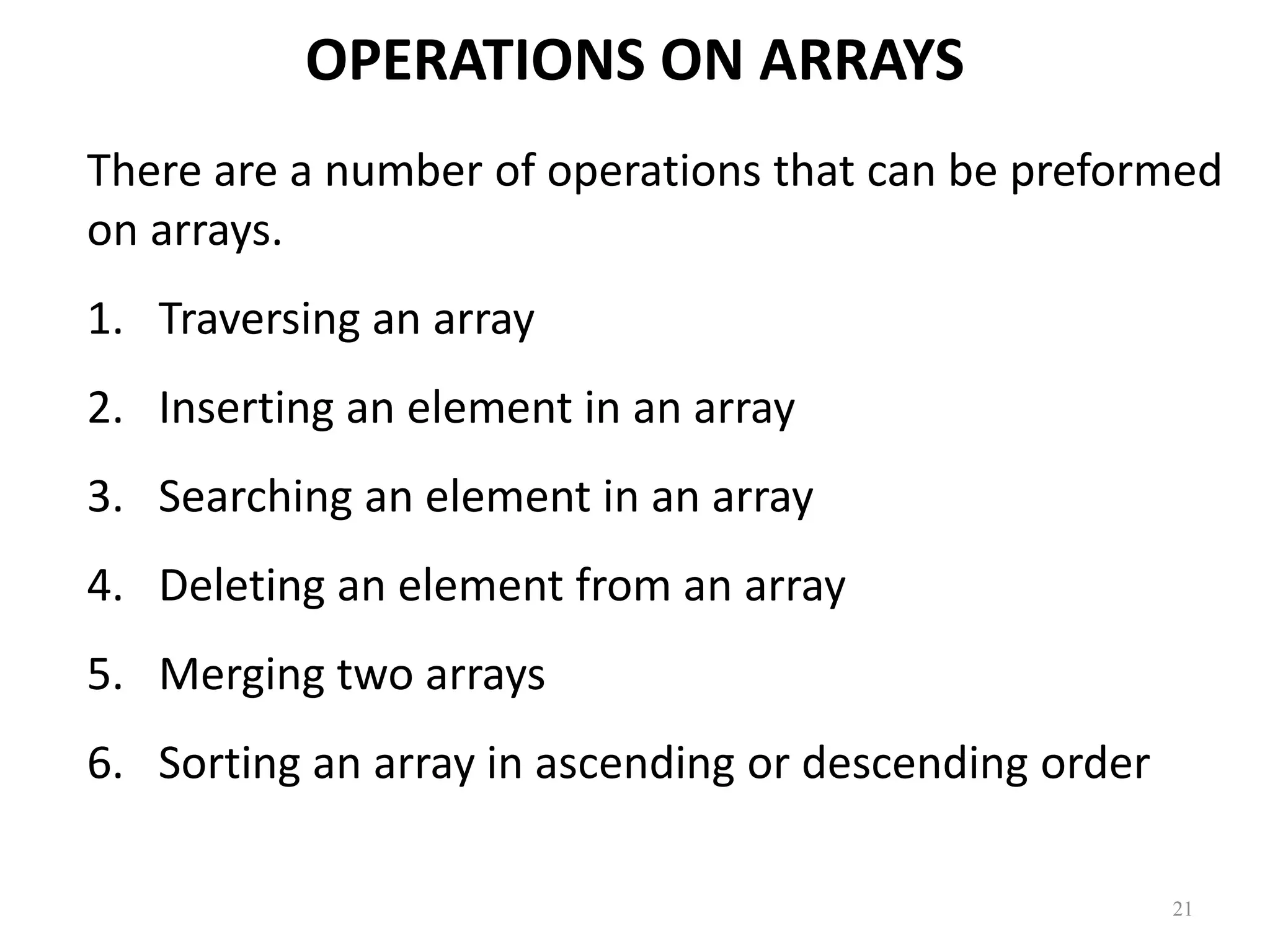
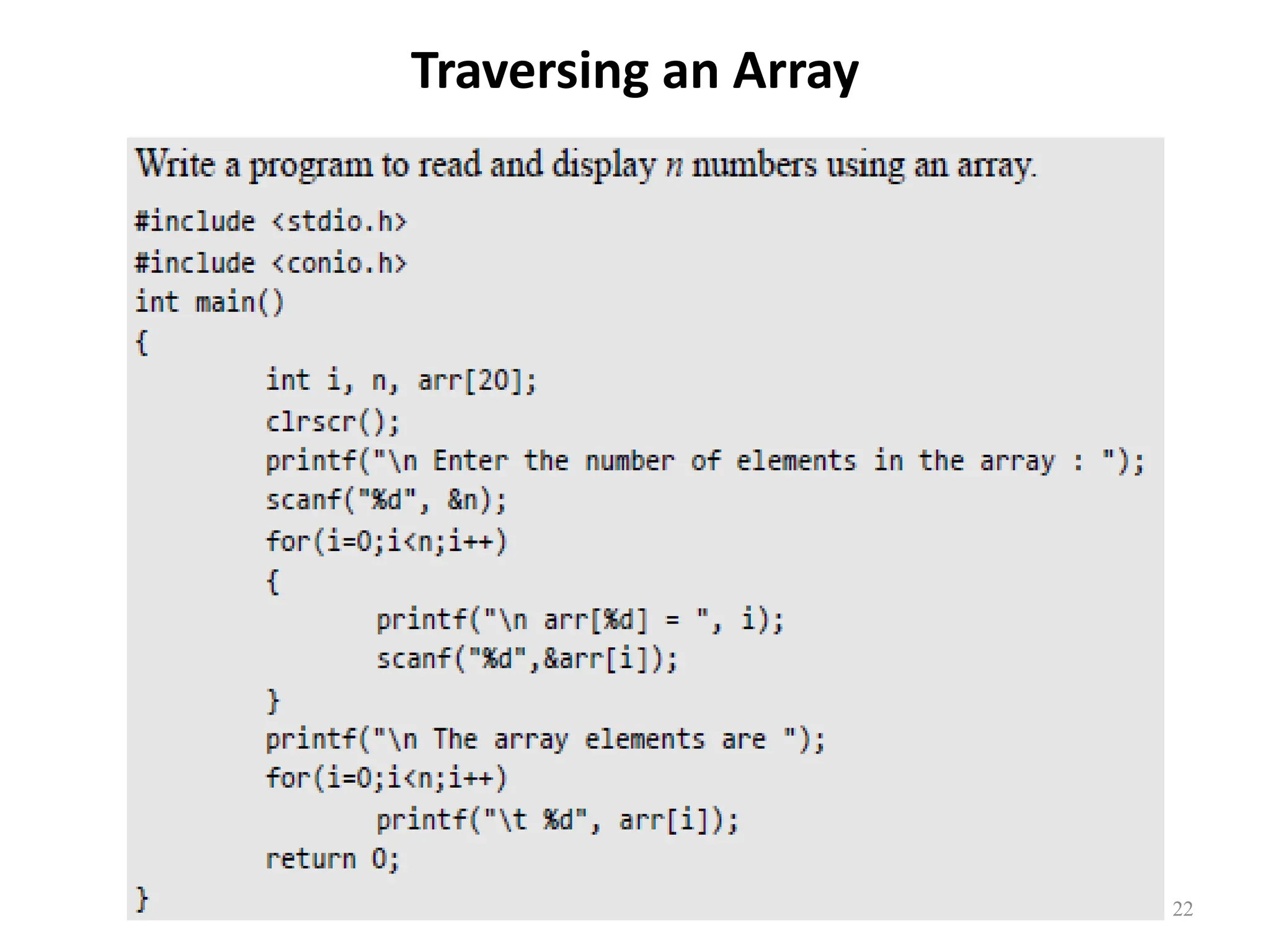
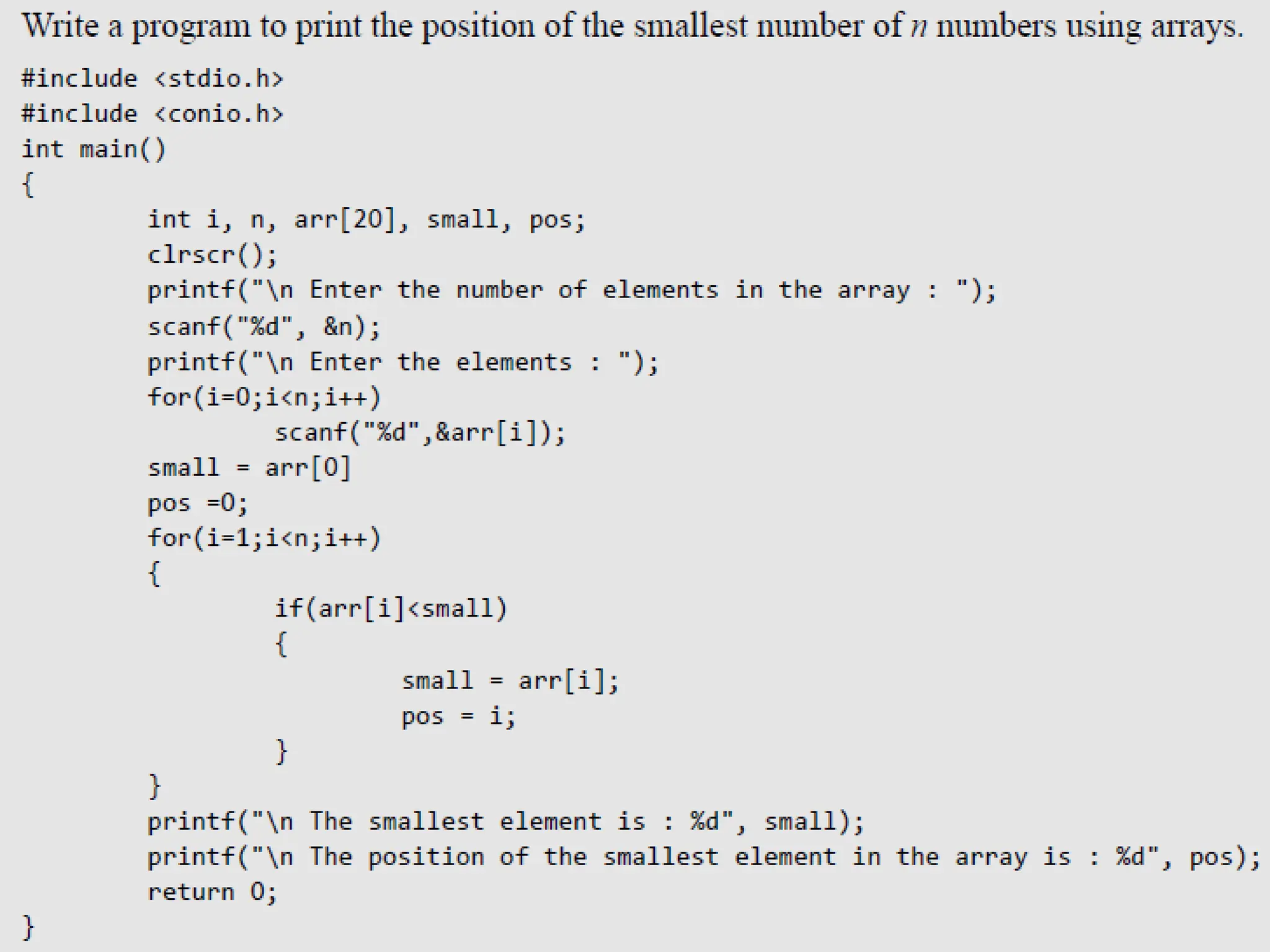
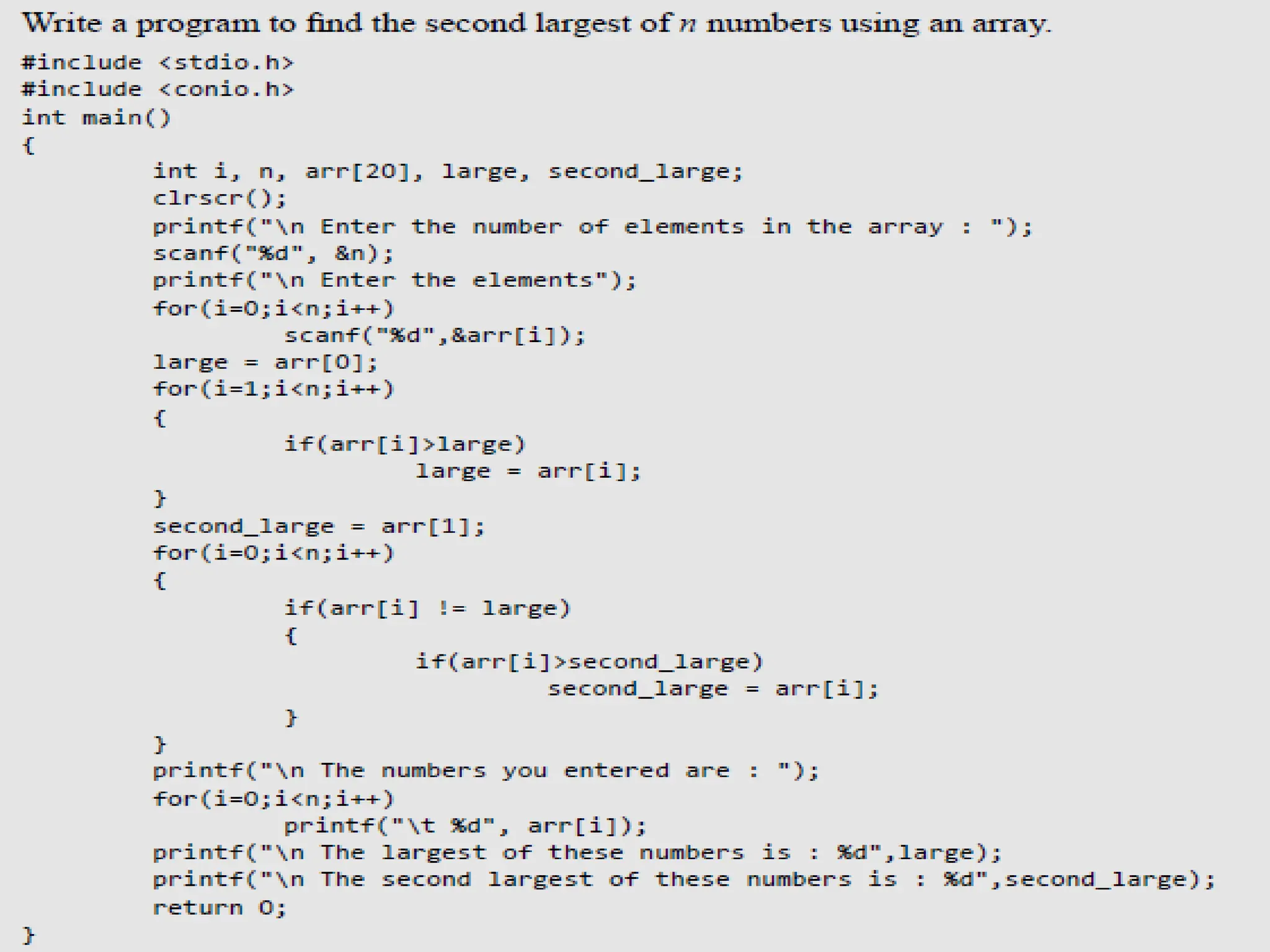
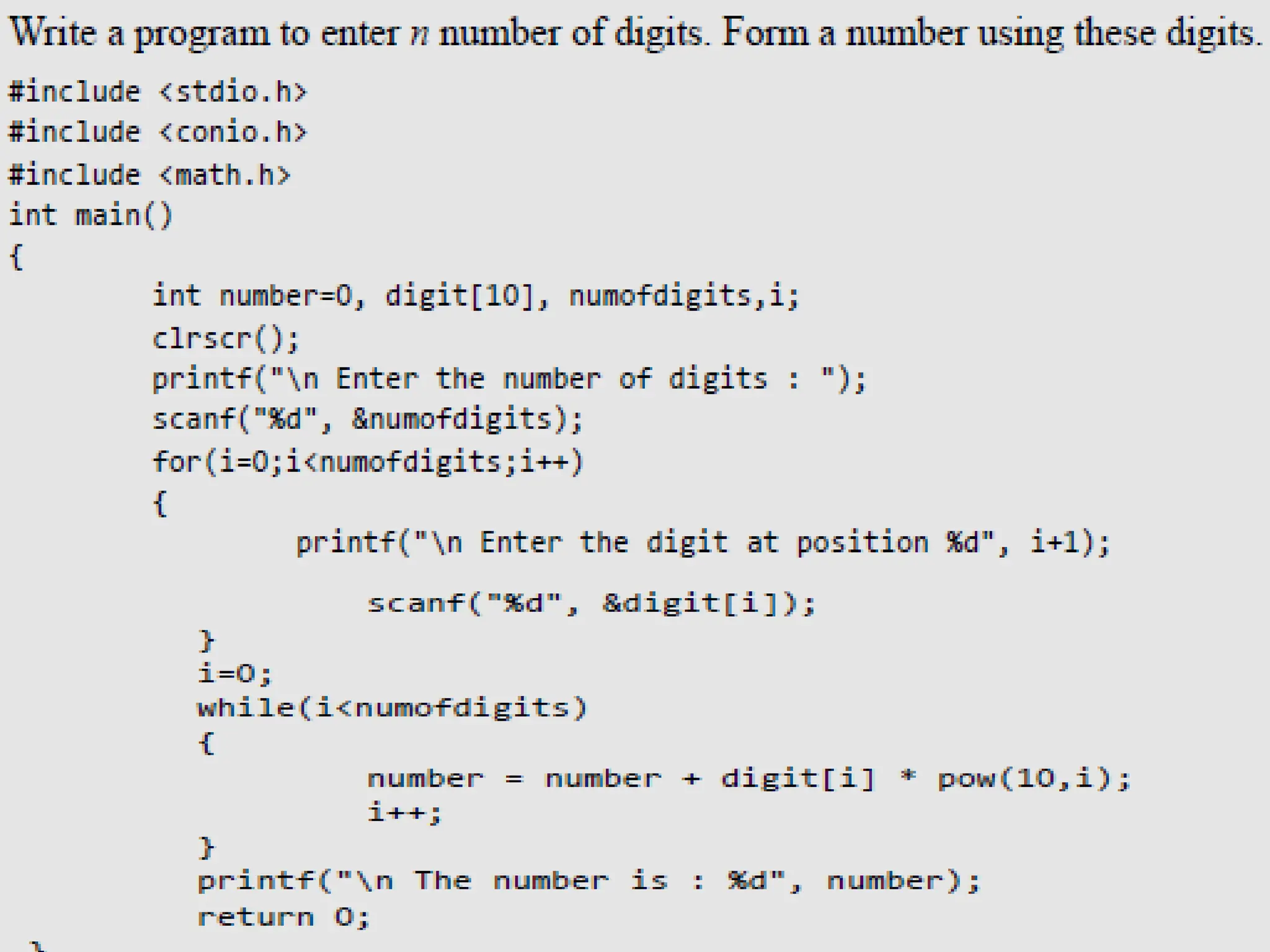
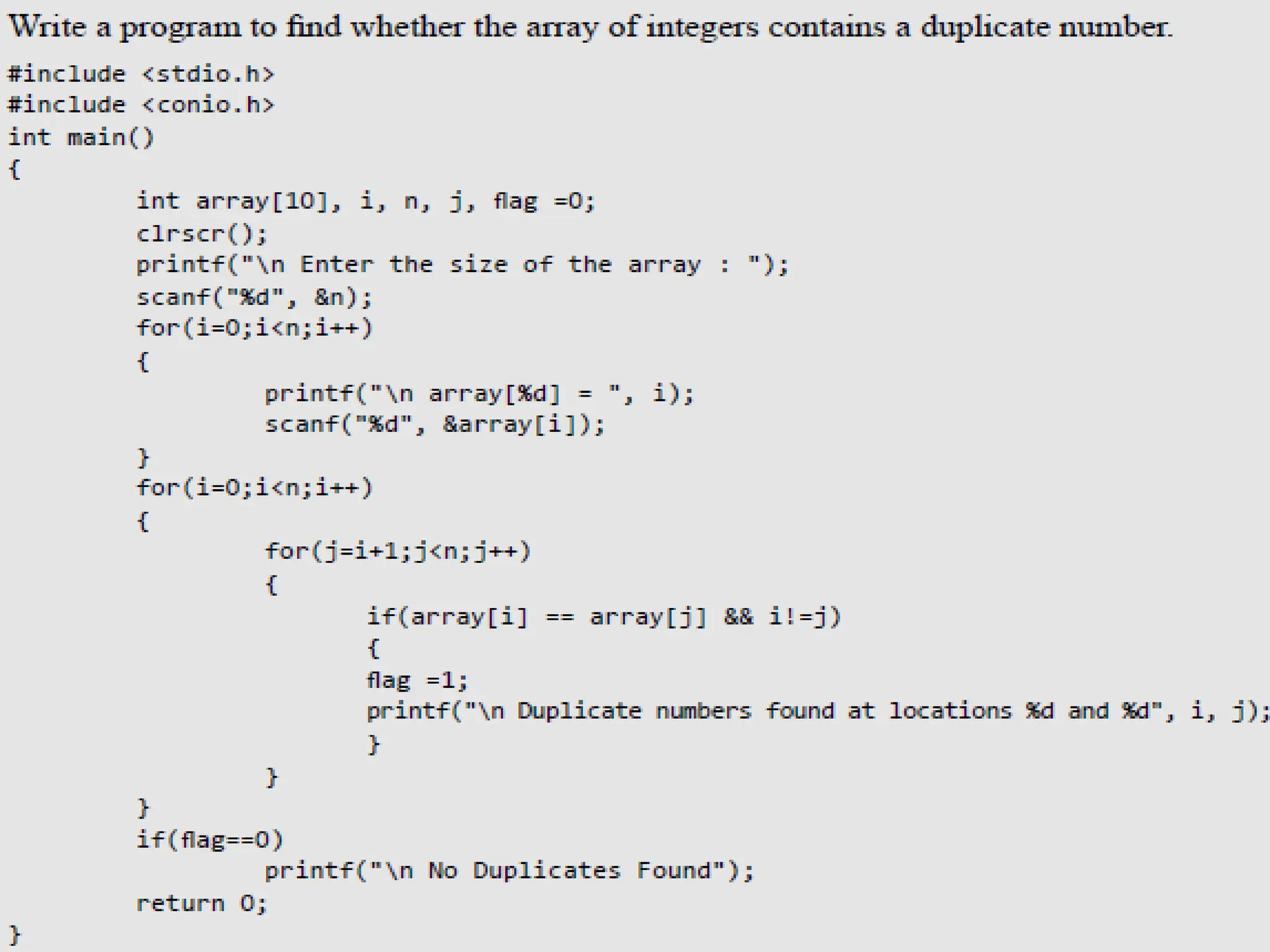
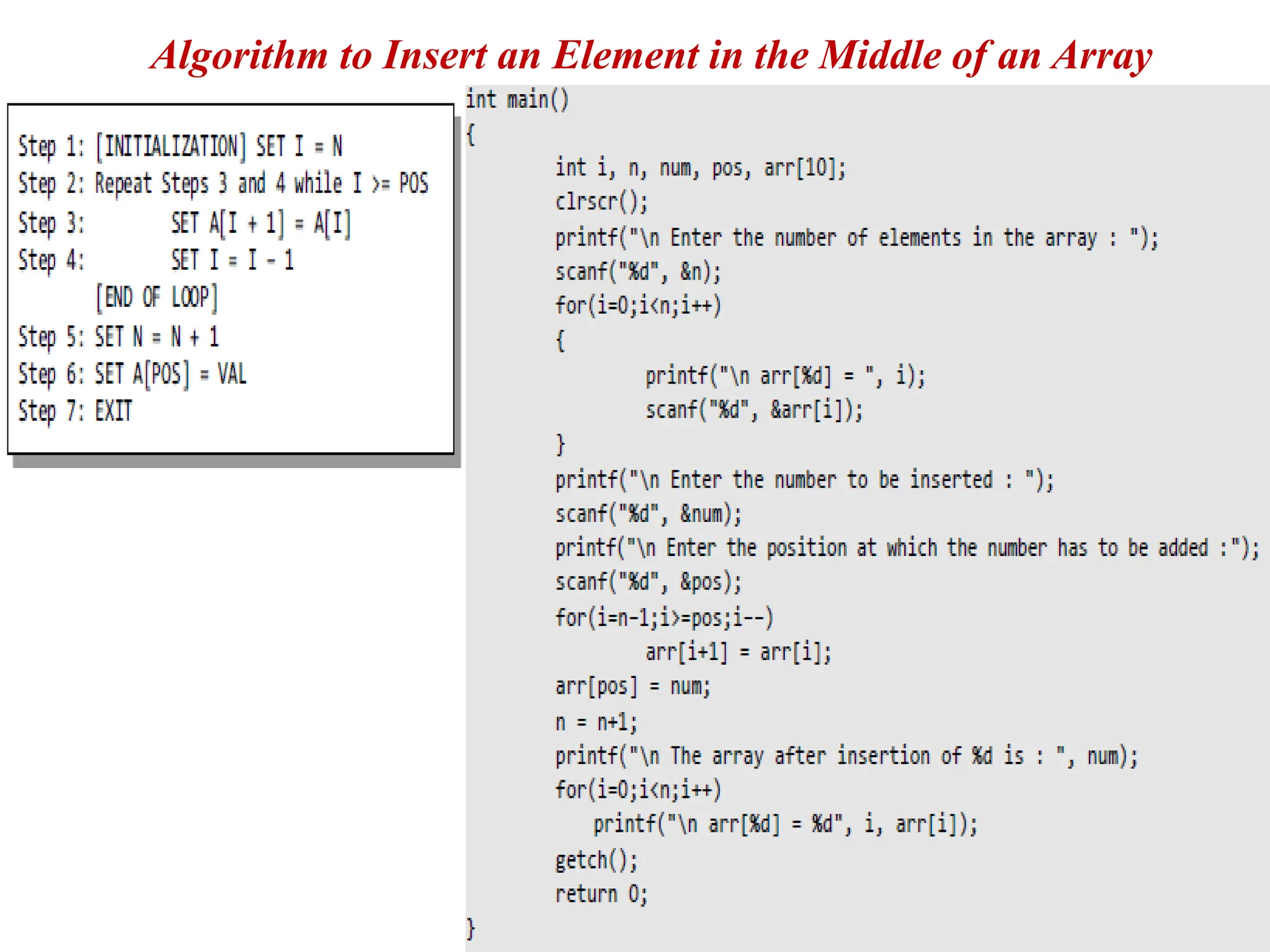
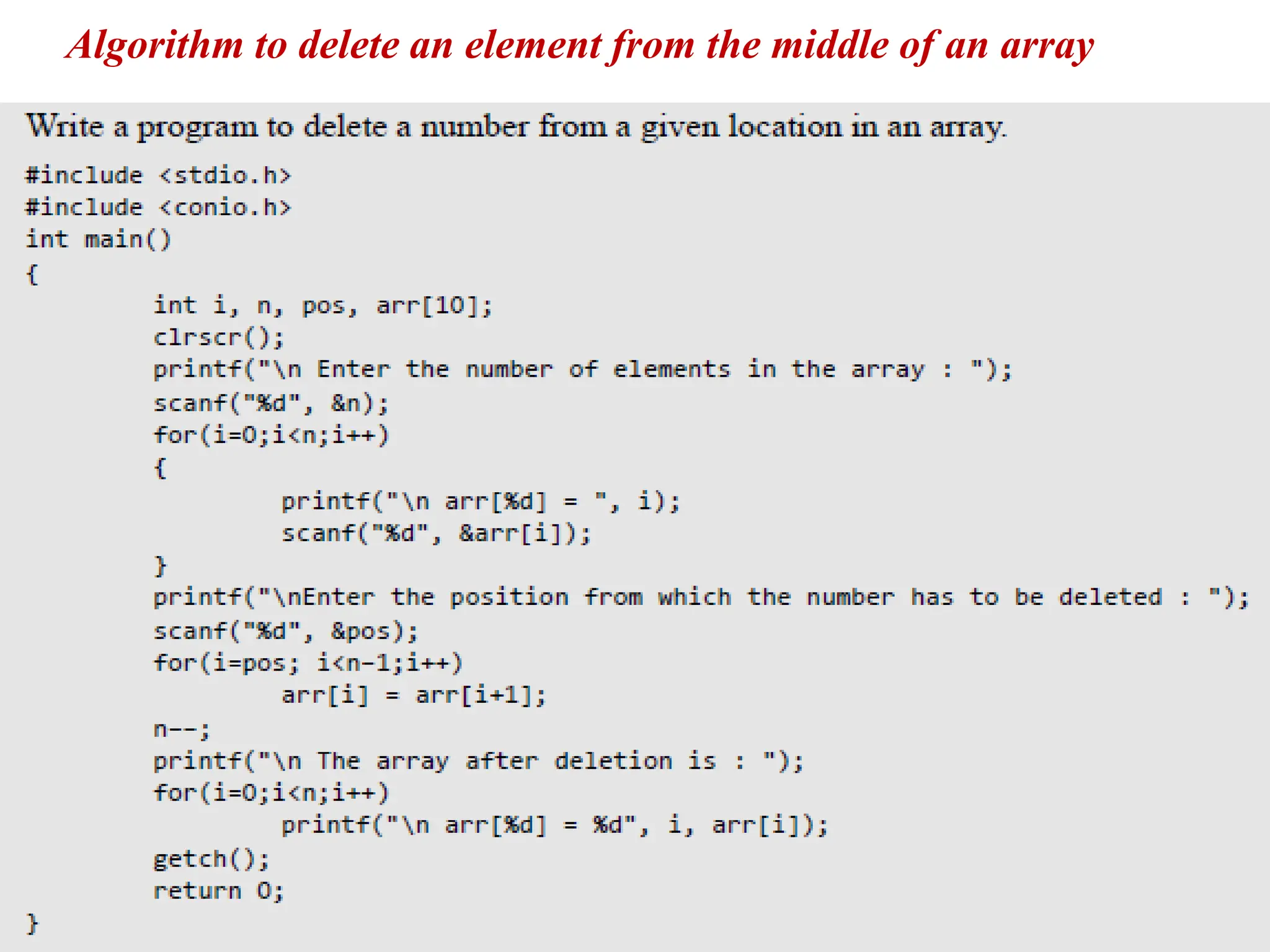
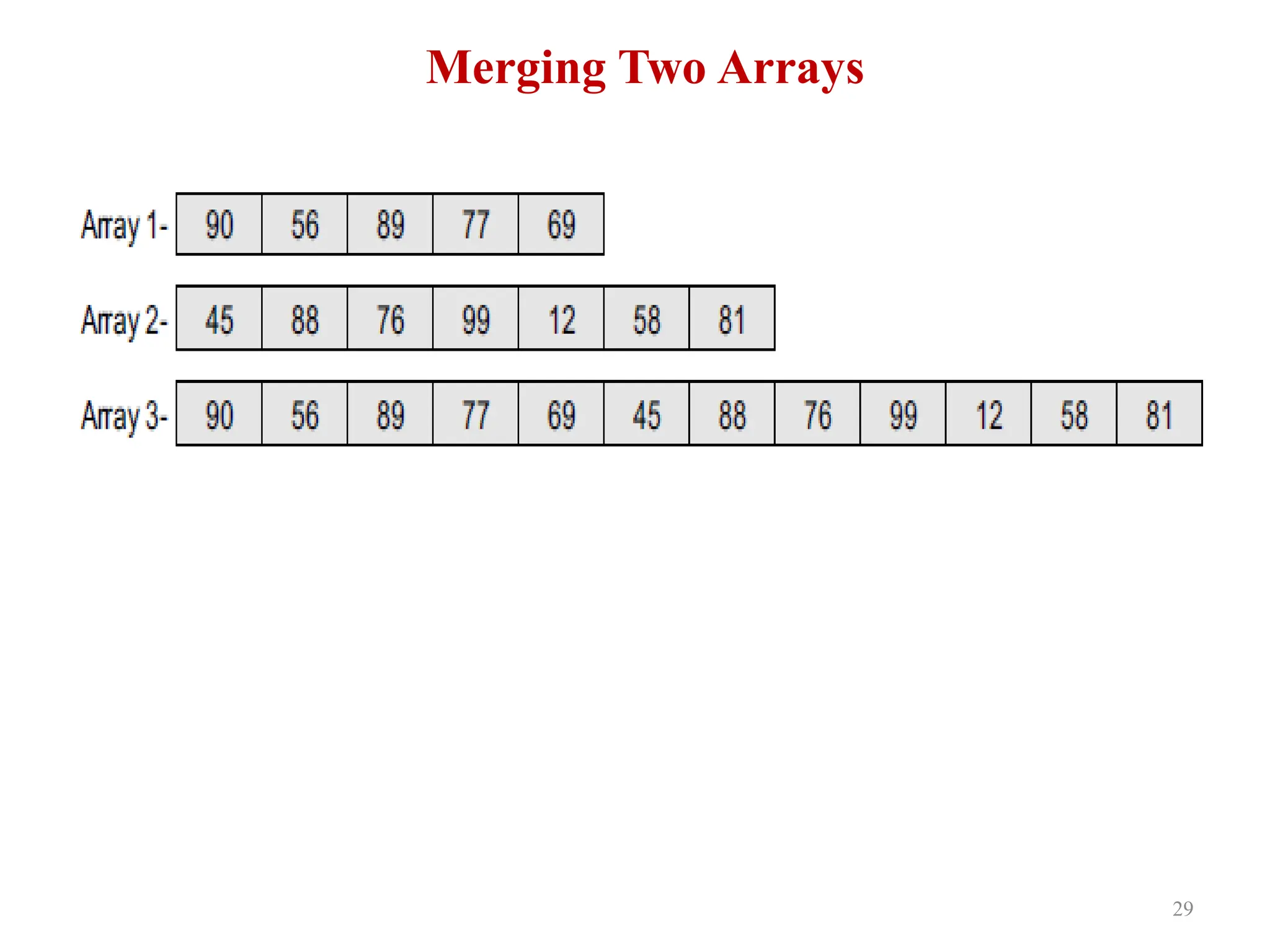
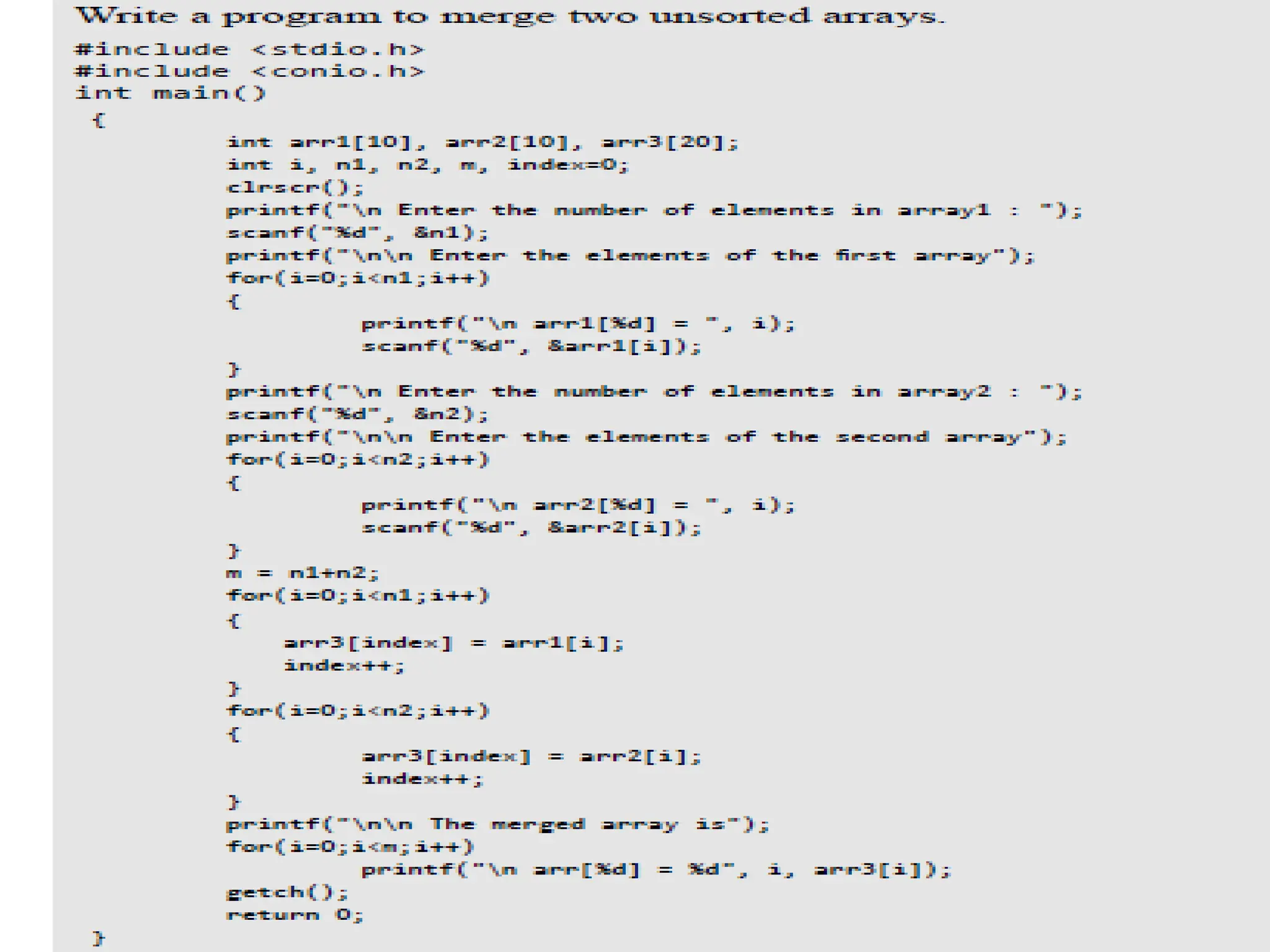
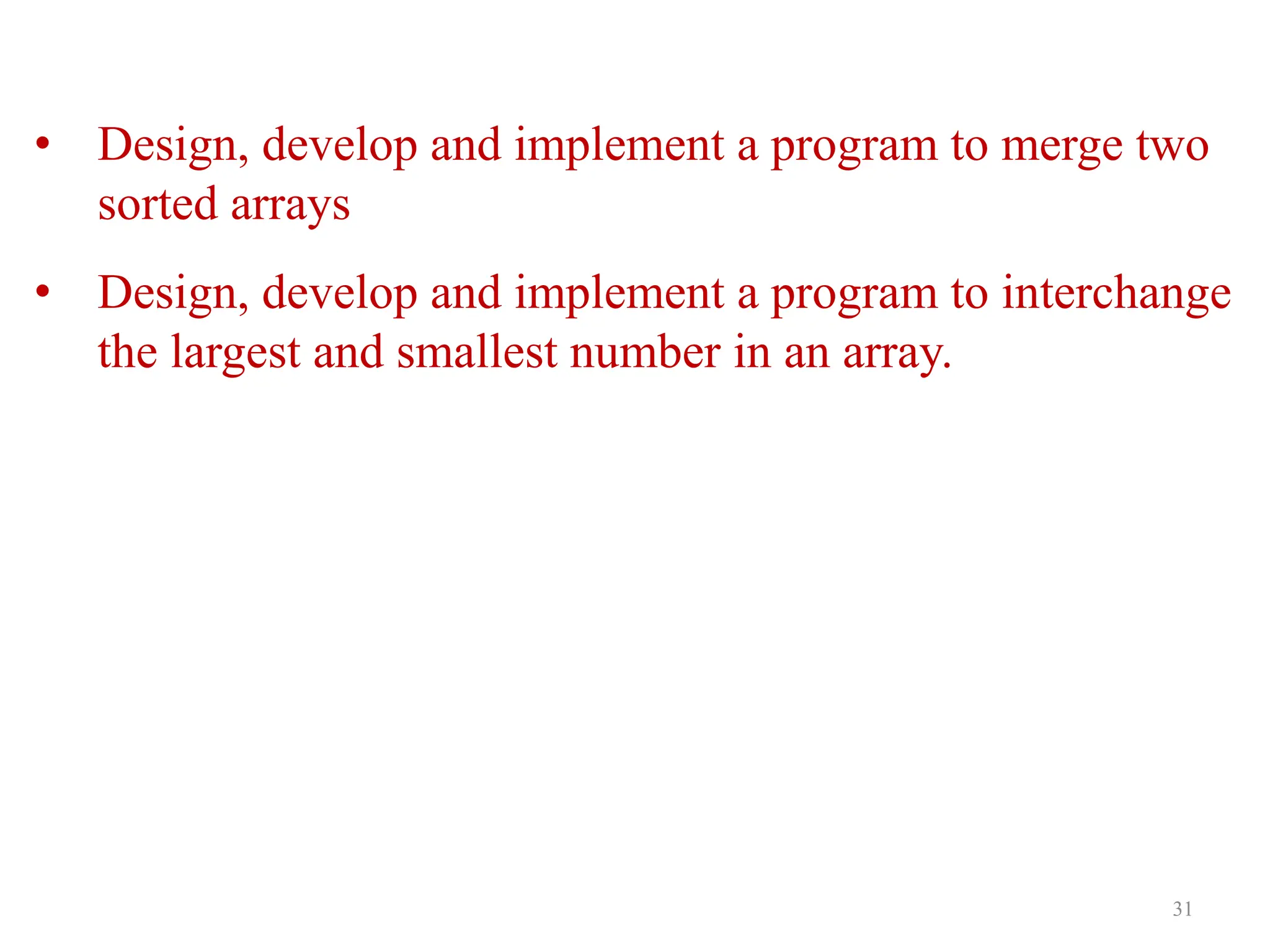
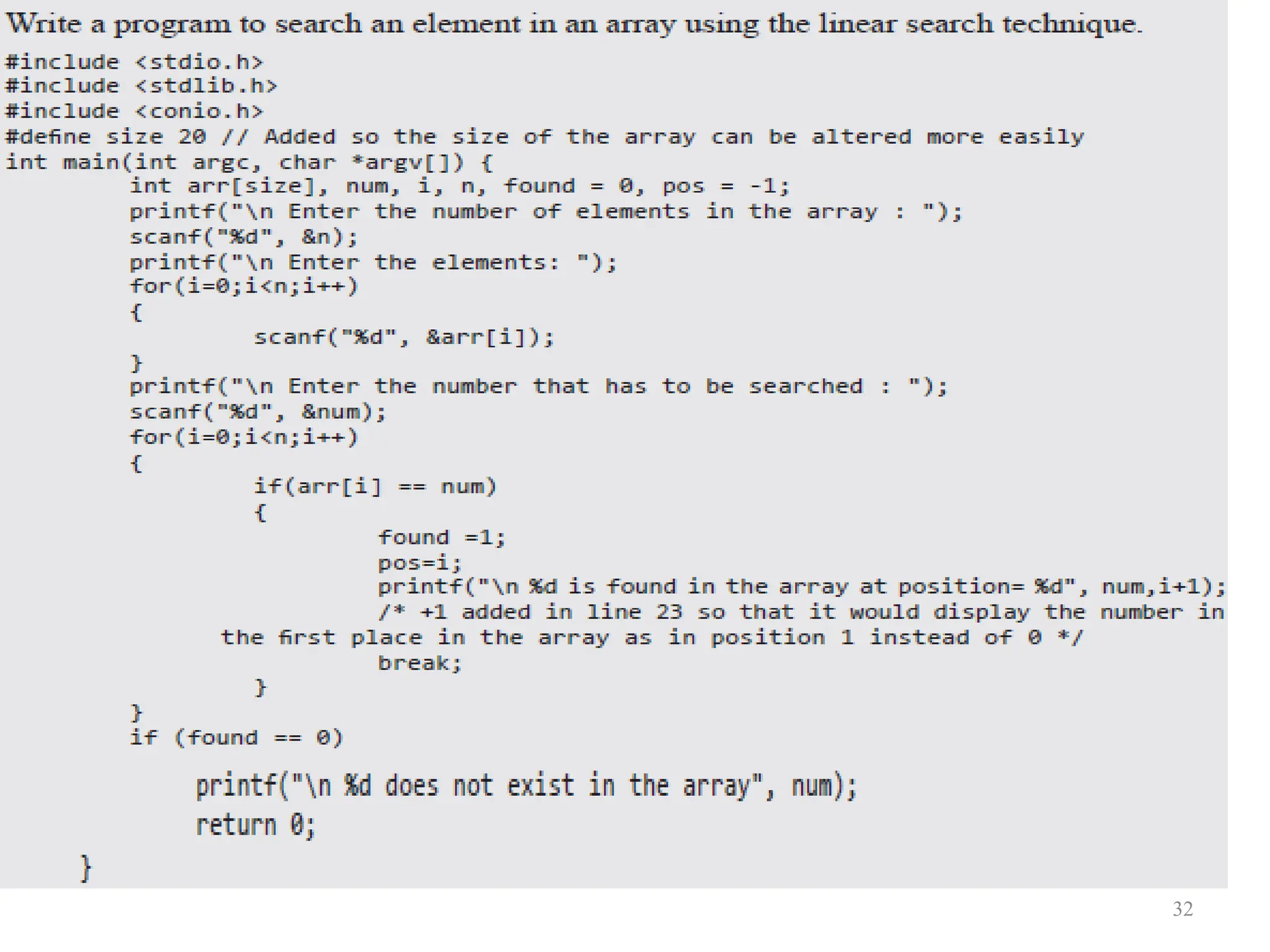
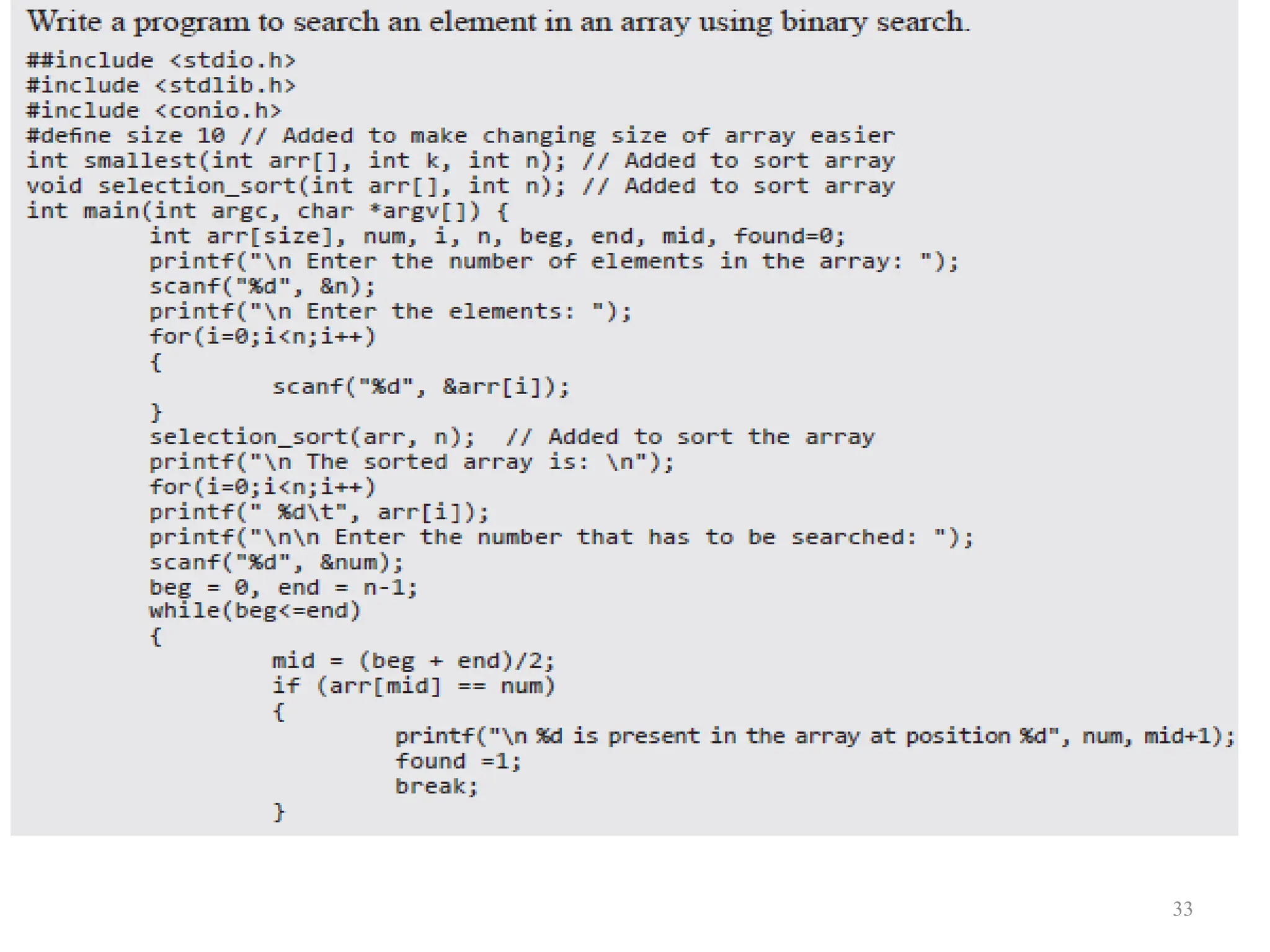
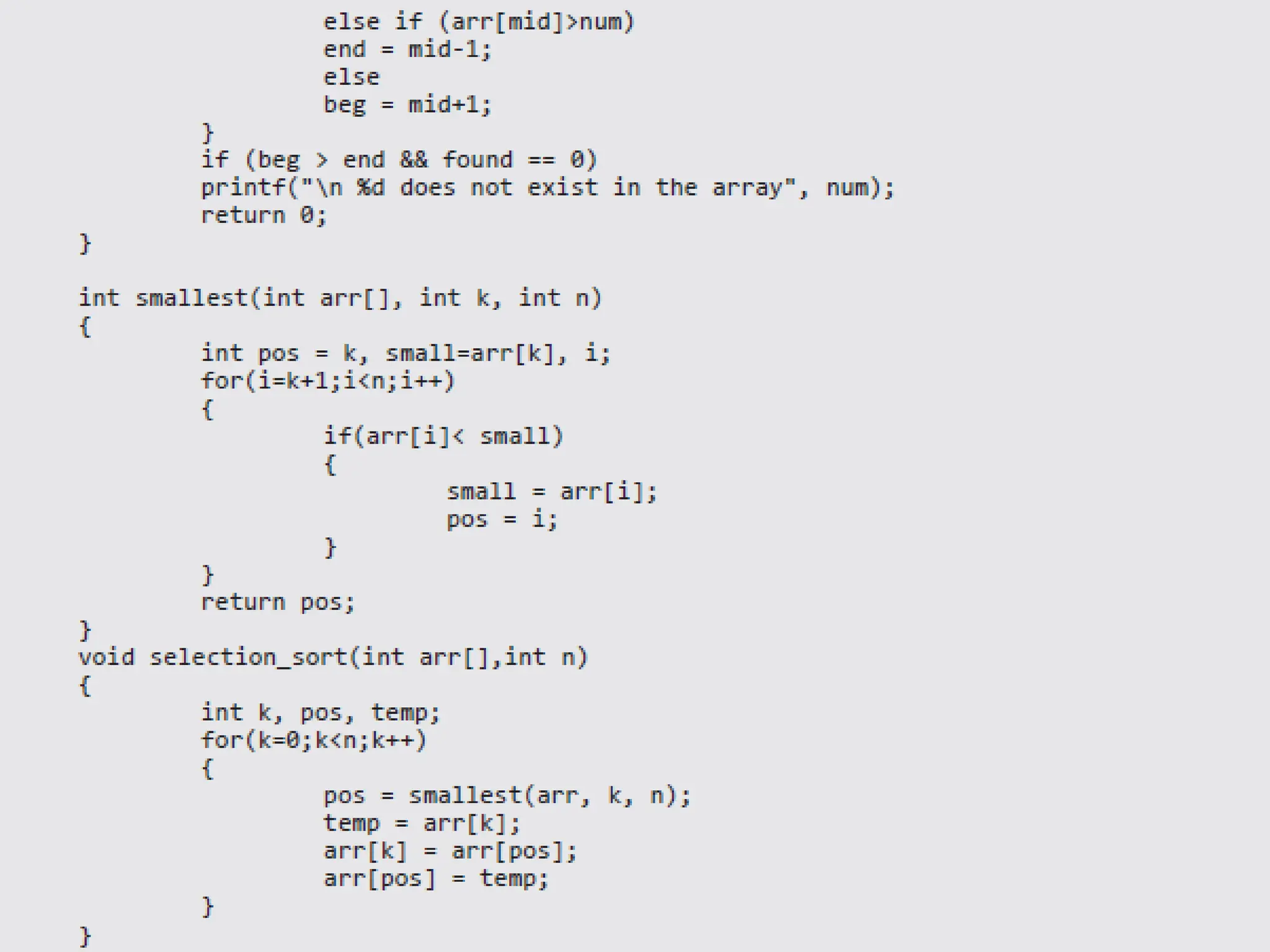
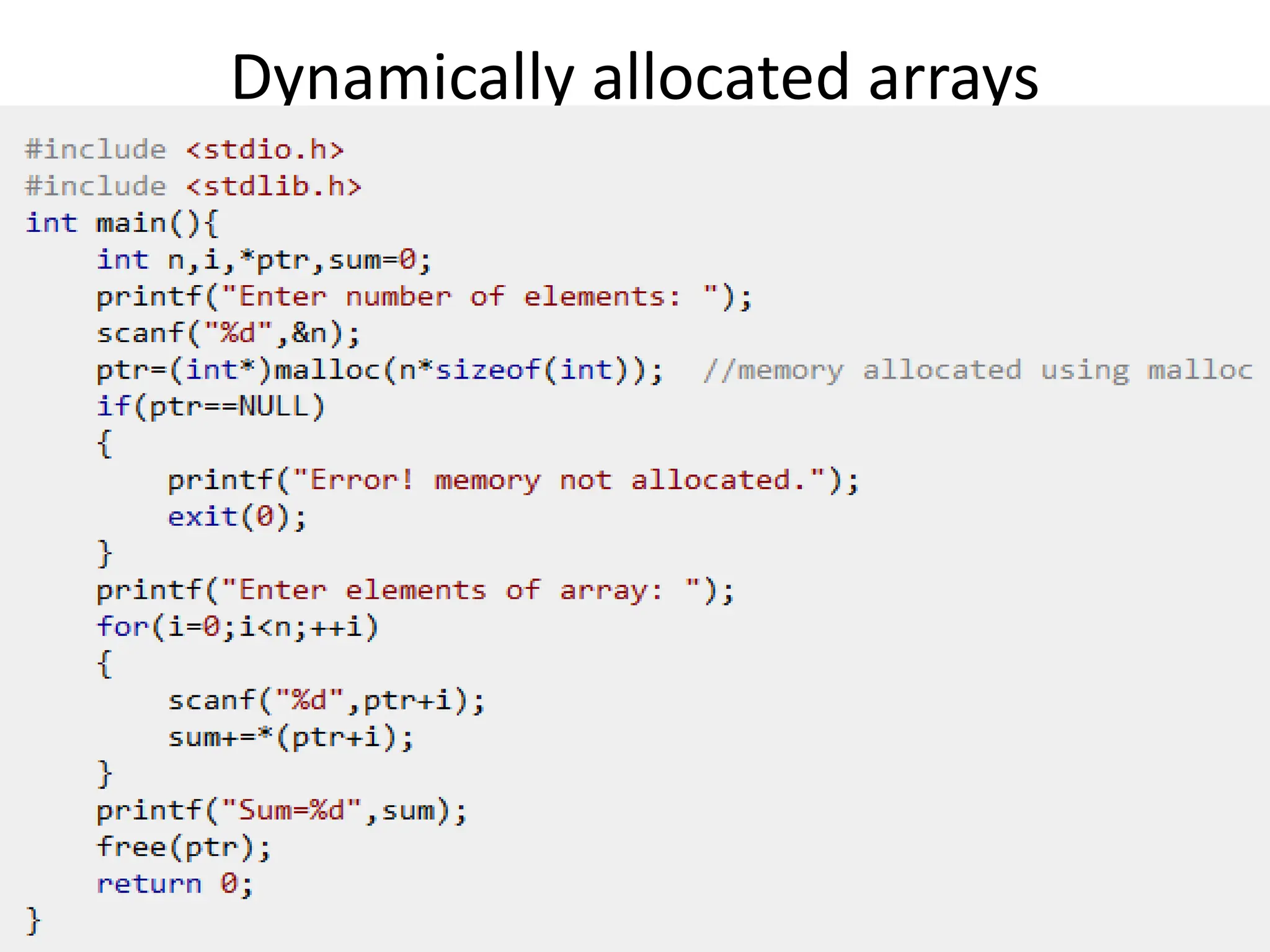
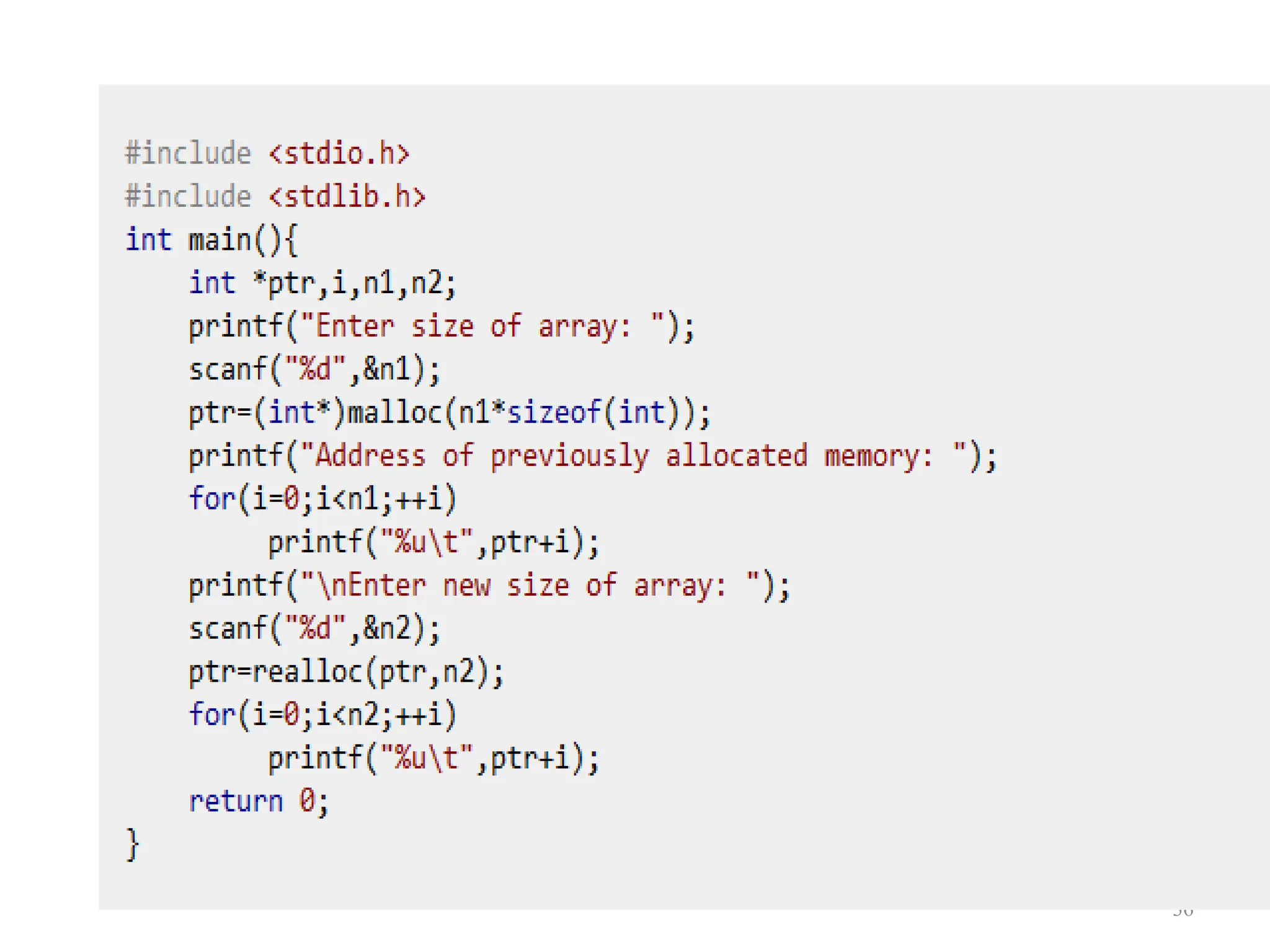
![ 2000 Prentice Hall, Inc. All rights reserved. 1. Initialize array 2. Loop 3. Print 37 1 /* 2 Histogram printing program */ 3 #include <stdio.h> 4 #define SIZE 10 5 6 int main() 7 { 8 int n[ SIZE ] = { 19, 3, 15, 7, 11, 9, 13, 5, 17, 1 }; 9 int i, j; 10 11 printf( "%s%13s%17sn", "Element", "Value", "Histogram" ); 12 13 for ( i = 0; i <= SIZE - 1; i++ ) { 14 printf( "%7d%13d ", i, n[ i ]) ; 15 16 for ( j = 1; j <= n[ i ]; j++ ) /* print one bar */ 17 printf( "%c", '*' ); 18 19 printf( "n" ); 20 } 21 22 return 0; 23 }](https://image.slidesharecdn.com/dsmodule-12023-240707035514-c76abc94/75/Basics-of-Data-structure-using-C-describing-basics-concepts-37-2048.jpg)
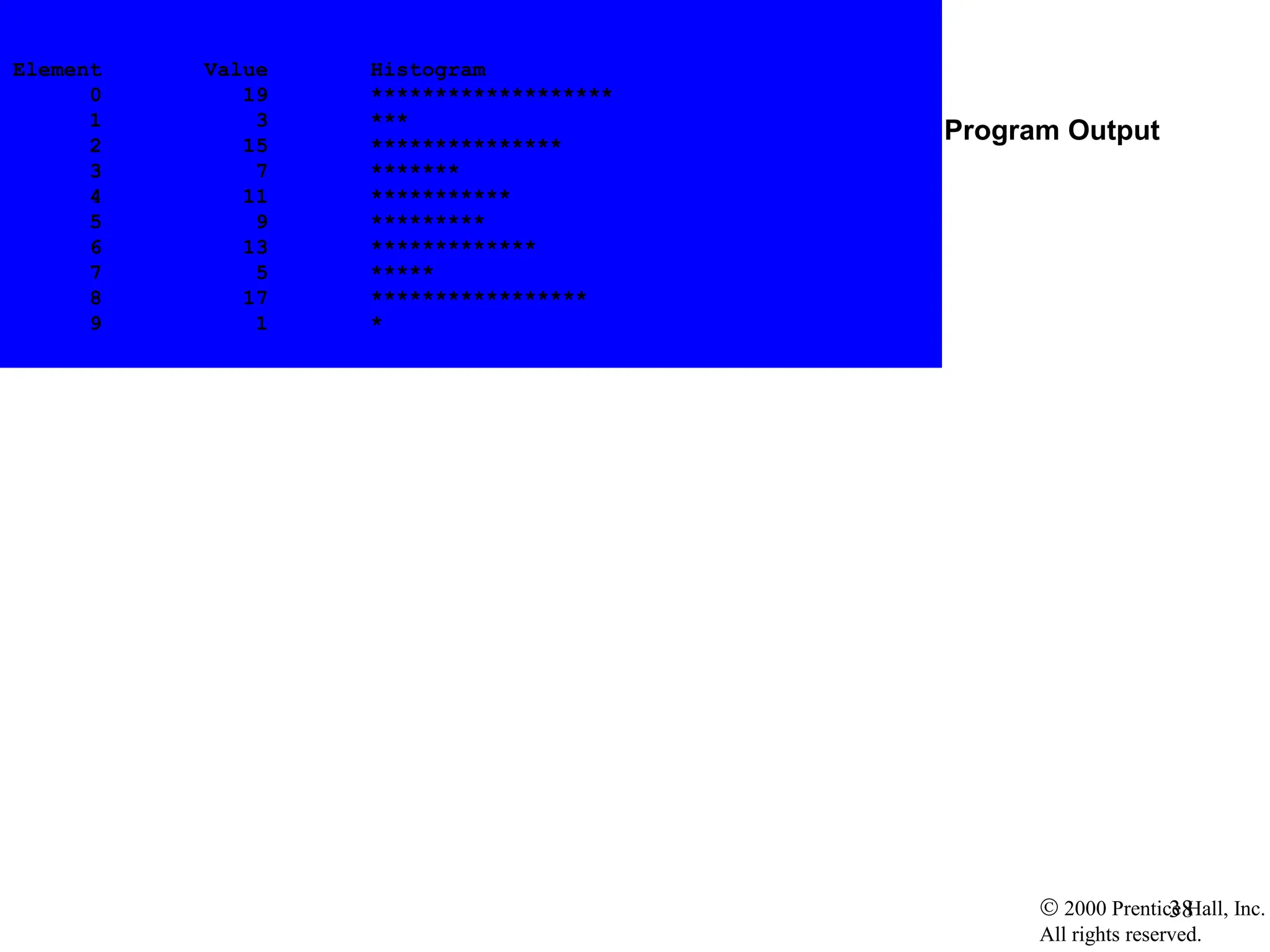
![Examples Using Arrays • Character arrays – String “first” is really a static array of characters – Character arrays can be initialized using string literals char string1[] = "first"; • Null character '0' terminates strings • string1 actually has 6 elements – It is equivalent to char string1[] = { 'f', 'i', 'r', 's', 't', '0' }; – Can access individual characters string1[ 3 ] is character ‘s’ – Array name is address of array, so & not needed for scanf scanf( "%s", string2 ); • Reads characters until whitespace encountered • Can write beyond end of array, be careful 39](https://image.slidesharecdn.com/dsmodule-12023-240707035514-c76abc94/75/Basics-of-Data-structure-using-C-describing-basics-concepts-39-2048.jpg)
![ 2000 Prentice Hall, Inc. All rights reserved. 1. Initialize strings 2. Print strings 2.1 Define loop 2.2 Print characters individually 2.3 Input string 3. Print string Program Output 40 2 /*Treating character arrays as strings */ 3 #include <stdio.h> 4 5 int main() 6 { 7 char string1[ 20 ], string2[] = "string literal"; 8 int i; 9 10 printf(" Enter a string: "); 11 scanf( "%s", string1 ); 12 printf( "string1 is: %snstring2: is %sn" 13 "string1 with spaces between characters is:n", 14 string1, string2 ); 15 16 for ( i = 0; string1[ i ] != '0'; i++ ) 17 printf( "%c ", string1[ i ] ); 18 19 printf( "n" ); 20 return 0; 21 } Enter a string: Hello there string1 is: Hello string2 is: string literal string1 with spaces between characters is: H e l l o](https://image.slidesharecdn.com/dsmodule-12023-240707035514-c76abc94/75/Basics-of-Data-structure-using-C-describing-basics-concepts-40-2048.jpg)
![Passing Arrays to Functions • Passing arrays – To pass an array argument to a function, specify the name of the array without any brackets int myArray[ 24 ]; myFunction( myArray, 24 ); • Array size usually passed to function – Arrays passed call-by-reference – Name of array is address of first element – Function knows where the array is stored • Modifies original memory locations • Passing array elements – Passed by call-by-value – Pass subscripted name (i.e., myArray[ 3 ]) to function 41](https://image.slidesharecdn.com/dsmodule-12023-240707035514-c76abc94/75/Basics-of-Data-structure-using-C-describing-basics-concepts-41-2048.jpg)
![Passing Arrays to Functions • Function prototype void modifyArray( int b[], int arraySize ); – Parameter names optional in prototype • int b[] could be written int [] • int arraySize could be simply int 42](https://image.slidesharecdn.com/dsmodule-12023-240707035514-c76abc94/75/Basics-of-Data-structure-using-C-describing-basics-concepts-42-2048.jpg)
![ 2000 Prentice Hall, Inc. All rights reserved. 1. Function definitions 2. Pass array to a function 2.1 Pass array element to a function 3. Print 43 1 /* 2 Passing arrays and individual array elements to functions */ 3 #include <stdio.h> 4 #define SIZE 5 5 6 void modifyArray( int [], int ); /* appears strange */ 7 void modifyElement( int ); 8 9 int main() 10 { 11 int a[ SIZE ] = { 0, 1, 2, 3, 4 }, i; 12 13 printf( "Effects of passing entire array call " 14 "by reference:nnThe values of the " 15 "original array are:n" ); 16 17 for ( i = 0; i <= SIZE - 1; i++ ) 18 printf( "%3d", a[ i ] ); 19 20 printf( "n" ); 21 modifyArray( a, SIZE ); /* passed call by reference */ 22 printf( "The values of the modified array are:n" ); 23 24 for ( i = 0; i <= SIZE - 1; i++ ) 25 printf( "%3d", a[ i ] ); 26 27 printf( "nnnEffects of passing array element call " 28 "by value:nnThe value of a[3] is %dn", a[ 3 ] ); 29 modifyElement( a[ 3 ] ); 30 printf( "The value of a[ 3 ] is %dn", a[ 3 ] ); 31 return 0; 32 } Entire arrays passed call-by- reference, and can be modified Array elements passed call-by- value, and cannot be modified](https://image.slidesharecdn.com/dsmodule-12023-240707035514-c76abc94/75/Basics-of-Data-structure-using-C-describing-basics-concepts-43-2048.jpg)
![ 2000 Prentice Hall, Inc. All rights reserved. 3.1 Function definitions Program Output 44 33 34 void modifyArray( int b[], int size ) 35 { 36 int j; 37 38 for ( j = 0; j <= size - 1; j++ ) 39 b[ j ] *= 2; 40 } 41 42 void modifyElement( int e ) 43 { 44 printf( "Value in modifyElement is %dn", e *= 2 ); 45 } Effects of passing entire array call by reference: The values of the original array are: 0 1 2 3 4 The values of the modified array are: 0 2 4 6 8 Effects of passing array element call by value: The value of a[3] is 6 Value in modifyElement is 12 The value of a[3] is 6](https://image.slidesharecdn.com/dsmodule-12023-240707035514-c76abc94/75/Basics-of-Data-structure-using-C-describing-basics-concepts-44-2048.jpg)
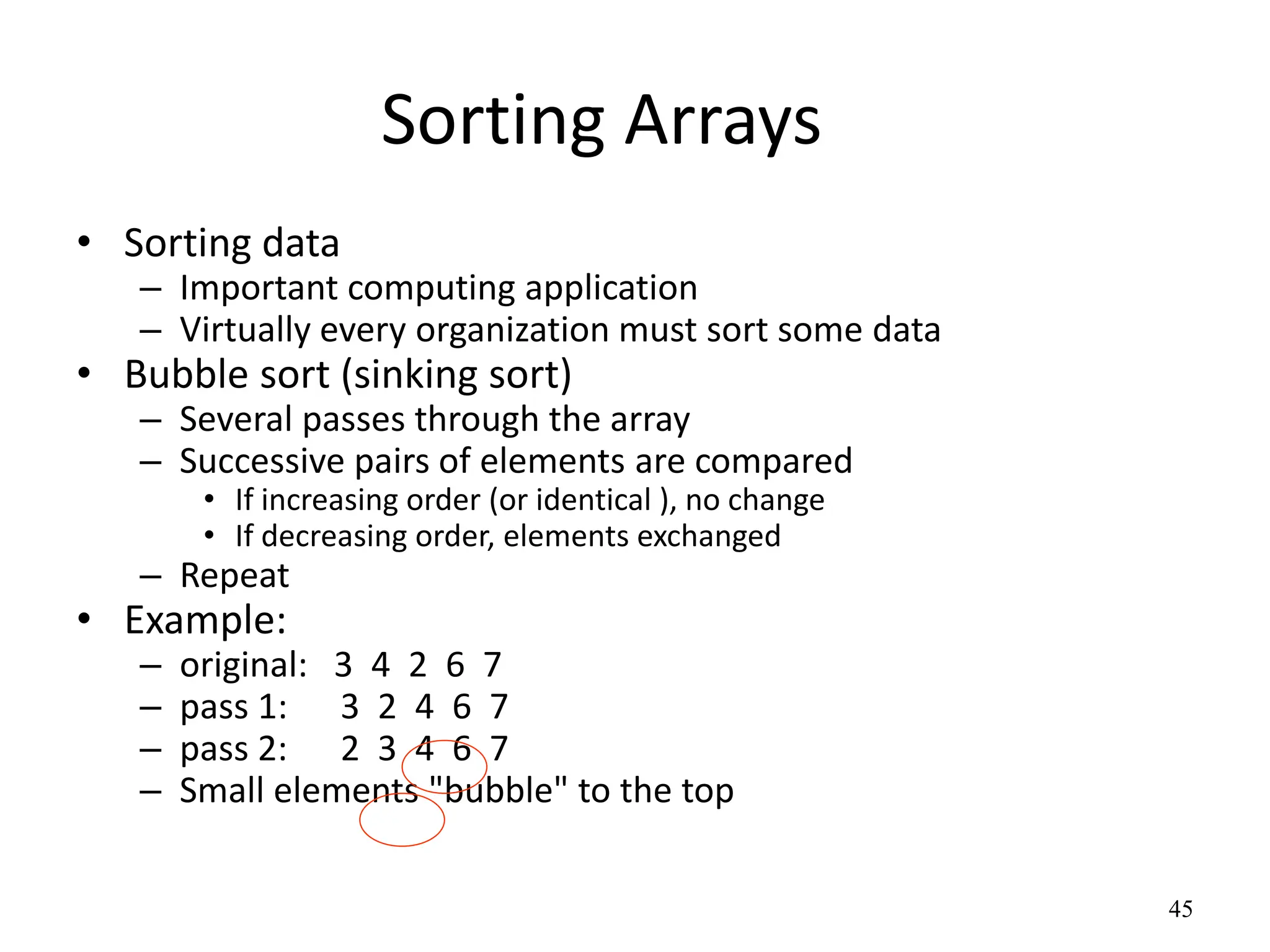
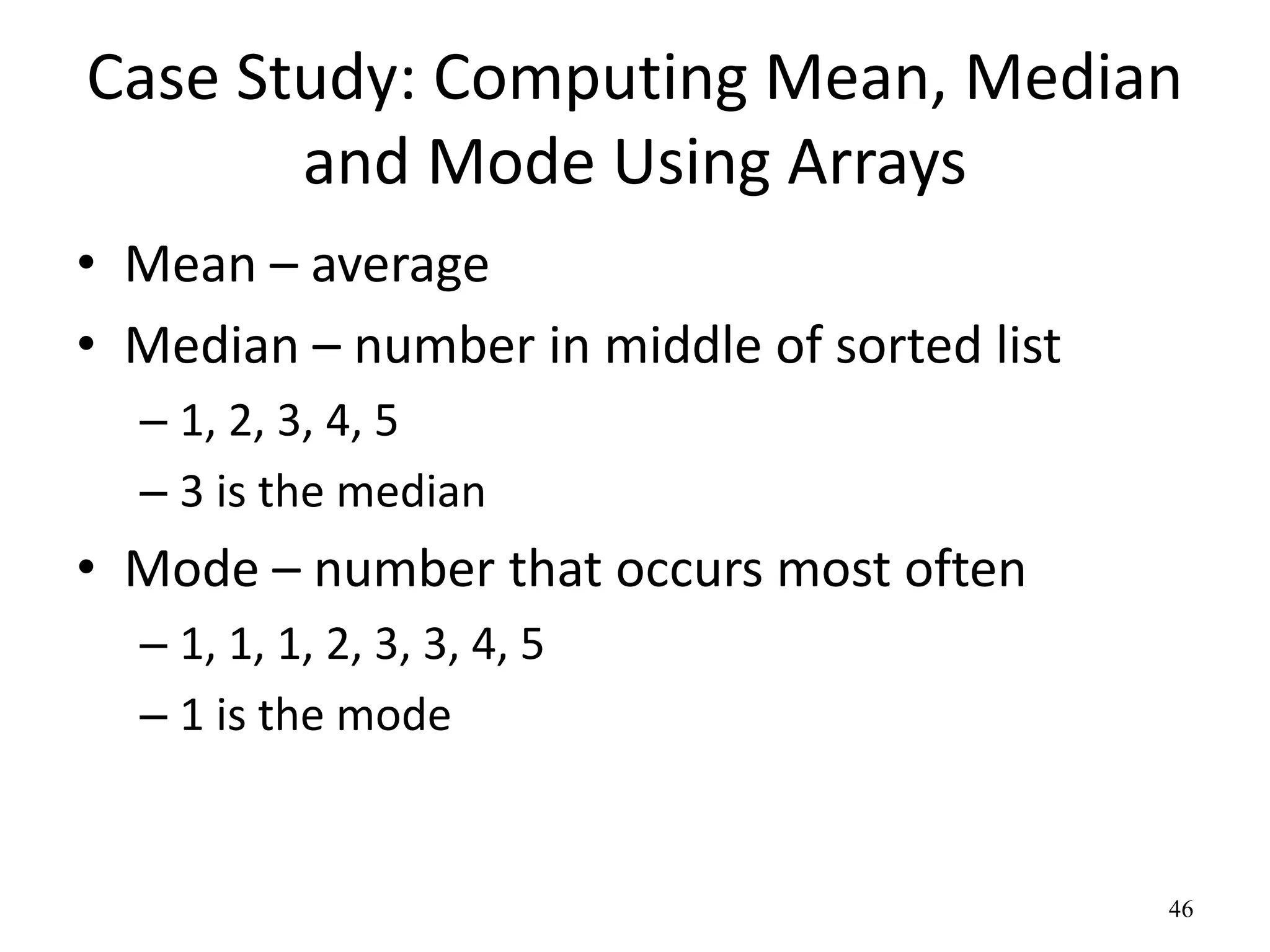
![ 2000 Prentice Hall, Inc. All rights reserved. 1. Function prototypes 1.1 Initialize array 2. Call functions mean, median, and mode 47 1 /* 2 This program introduces the topic of survey data analysis. 3 It computes the mean, median, and mode of the data */ 4 #include <stdio.h> 5 #define SIZE 99 6 7 void mean( const int [] ); 8 void median( int [] ); 9 void mode( int [], const int [] ) ; 10 void bubbleSort( int [] ); 11 void printArray( const int [] ); 12 13 int main() 14 { 15 int frequency[ 10 ] = { 0 }; 16 int response[ SIZE ] = 17 { 6, 7, 8, 9, 8, 7, 8, 9, 8, 9, 18 7, 8, 9, 5, 9, 8, 7, 8, 7, 8, 19 6, 7, 8, 9, 3, 9, 8, 7, 8, 7, 20 7, 8, 9, 8, 9, 8, 9, 7, 8, 9, 21 6, 7, 8, 7, 8, 7, 9, 8, 9, 2, 22 7, 8, 9, 8, 9, 8, 9, 7, 5, 3, 23 5, 6, 7, 2, 5, 3, 9, 4, 6, 4, 24 7, 8, 9, 6, 8, 7, 8, 9, 7, 8, 25 7, 4, 4, 2, 5, 3, 8, 7, 5, 6, 26 4, 5, 6, 1, 6, 5, 7, 8, 7 }; 27 28 mean( response ); 29 median( response ); 30 mode( frequency, response ); 31 return 0; 32 }](https://image.slidesharecdn.com/dsmodule-12023-240707035514-c76abc94/75/Basics-of-Data-structure-using-C-describing-basics-concepts-47-2048.jpg)
![ 2000 Prentice Hall, Inc. All rights reserved. 3. Define function mean 3.1 Define function median 3.1.1 Sort Array 3.1.2 Print middle element 48 33 34 void mean( const int answer[] ) 35 { 36 int j, total = 0; 37 38 printf( "%sn%sn%sn", "********", " Mean", "********" ); 39 40 for ( j = 0; j <= SIZE - 1; j++ ) 41 total += answer[ j ]; 42 43 printf( "The mean is the average value of the datan" 44 "items. The mean is equal to the total ofn" 45 "all the data items divided by the numbern" 46 "of data items ( %d ). The mean value forn" 47 "this run is: %d / %d = %.4fnn", 48 SIZE, total, SIZE, ( double ) total / SIZE ); 49 } 50 51 void median( int answer[] ) 52 { 53 printf( "n%sn%sn%sn%s", 54 "********", " Median", "********", 55 "The unsorted array of responses is" ); 56 57 printArray( answer ); 58 bubbleSort( answer ); 59 printf( "nnThe sorted array is" ); 60 printArray( answer ); 61 printf( "nnThe median is element %d ofn" 62 "the sorted %d element array.n" 63 "For this run the median is %dnn", 64 SIZE / 2, SIZE, answer[ SIZE / 2 ] );](https://image.slidesharecdn.com/dsmodule-12023-240707035514-c76abc94/75/Basics-of-Data-structure-using-C-describing-basics-concepts-48-2048.jpg)
![ 2000 Prentice Hall, Inc. All rights reserved. 49 65 } 66 67 void mode( int freq[], const int answer[] ) 68 { 69 int rating, j, h, largest = 0, modeValue = 0; 70 71 printf( "n%sn%sn%sn", 72 "********", " Mode", "********" ); 73 74 for ( rating = 1; rating <= 9; rating++ ) 75 freq[ rating ] = 0; 76 77 for ( j = 0; j <= SIZE - 1; j++ ) 78 ++freq[ answer[ j ] ]; 79 80 printf( "%s%11s%19snn%54sn%54snn", 81 "Response", "Frequency", "Histogram", 82 "1 1 2 2", "5 0 5 0 5" ); 83 84 for ( rating = 1; rating <= 9; rating++ ) { 85 printf( "%8d%11d ", rating, freq[ rating ] ); 86 87 if ( freq[ rating ] > largest ) { 88 largest = freq[ rating ]; 89 modeValue = rating; 90 } 91 92 for ( h = 1; h <= freq[ rating ]; h++ ) 93 printf( "*" ); 94 3.2 Define function mode 3.2.1 Increase frequency[] depending on response[] Notice how the subscript in frequency[] is the value of an element in response[] (answer[]) Print stars depending on value of frequency[]](https://image.slidesharecdn.com/dsmodule-12023-240707035514-c76abc94/75/Basics-of-Data-structure-using-C-describing-basics-concepts-49-2048.jpg)
![ 2000 Prentice Hall, Inc. All rights reserved. 3.3 Define bubbleSort 3.3 Define printArray 50 95 printf( "n" ); 96 } 97 98 printf( "The mode is the most frequent value.n" 99 "For this run the mode is %d which occurred" 100 " %d times.n", modeValue, largest ); 101} 102 103 void bubbleSort( int a[] ) 104 { 105 int pass, j, hold; 106 107 for ( pass = 1; pass <= SIZE - 1; pass++ ) 108 109 for ( j = 0; j <= SIZE - 2; j++ ) 110 111 if ( a[ j ] > a[ j + 1 ] ) { 112 hold = a[ j ]; 113 a[ j ] = a[ j + 1 ]; 114 a[ j + 1 ] = hold; 115 } 116 } 117 118 void printArray( const int a[] ) 119 { 120 int j; 121 122 for ( j = 0; j <= SIZE - 1; j++ ) { 123 124 if ( j % 20 == 0 ) 125 printf( "n" ); Bubble sort: if elements out of order, swap them.](https://image.slidesharecdn.com/dsmodule-12023-240707035514-c76abc94/75/Basics-of-Data-structure-using-C-describing-basics-concepts-50-2048.jpg)
![ 2000 Prentice Hall, Inc. All rights reserved. Program Output 51 126 127 printf( "%2d", a[ j ] ); 128 } 129 } ******** Mean ******** The mean is the average value of the data items. The mean is equal to the total of all the data items divided by the number of data items (99). The mean value for this run is: 681 / 99 = 6.8788 ******** Median ******** The unsorted array of responses is 7 8 9 8 7 8 9 8 9 7 8 9 5 9 8 7 8 7 8 6 7 8 9 3 9 8 7 8 7 7 8 9 8 9 8 9 7 8 9 6 7 8 7 8 7 9 8 9 2 7 8 9 8 9 8 9 7 5 3 5 6 7 2 5 3 9 4 6 4 7 8 9 6 8 7 8 9 7 8 7 4 4 2 5 3 8 7 5 6 4 5 6 1 6 5 7 8 7 The sorted array is 1 2 2 2 3 3 3 3 4 4 4 4 4 5 5 5 5 5 5 5 5 6 6 6 6 6 6 6 6 6 7 7 7 7 7 7 7 7 7 7 7 7 7 7 7 7 7 7 7 7 7 7 7 8 8 8 8 8 8 8 8 8 8 8 8 8 8 8 8 8 8 8 8 8 8 8 8 8 8 8 9 9 9 9 9 9 9 9 9 9 9 9 9 9 9 9 9 9 9 The median is element 49 of the sorted 99 element array. For this run the median is 7](https://image.slidesharecdn.com/dsmodule-12023-240707035514-c76abc94/75/Basics-of-Data-structure-using-C-describing-basics-concepts-51-2048.jpg)
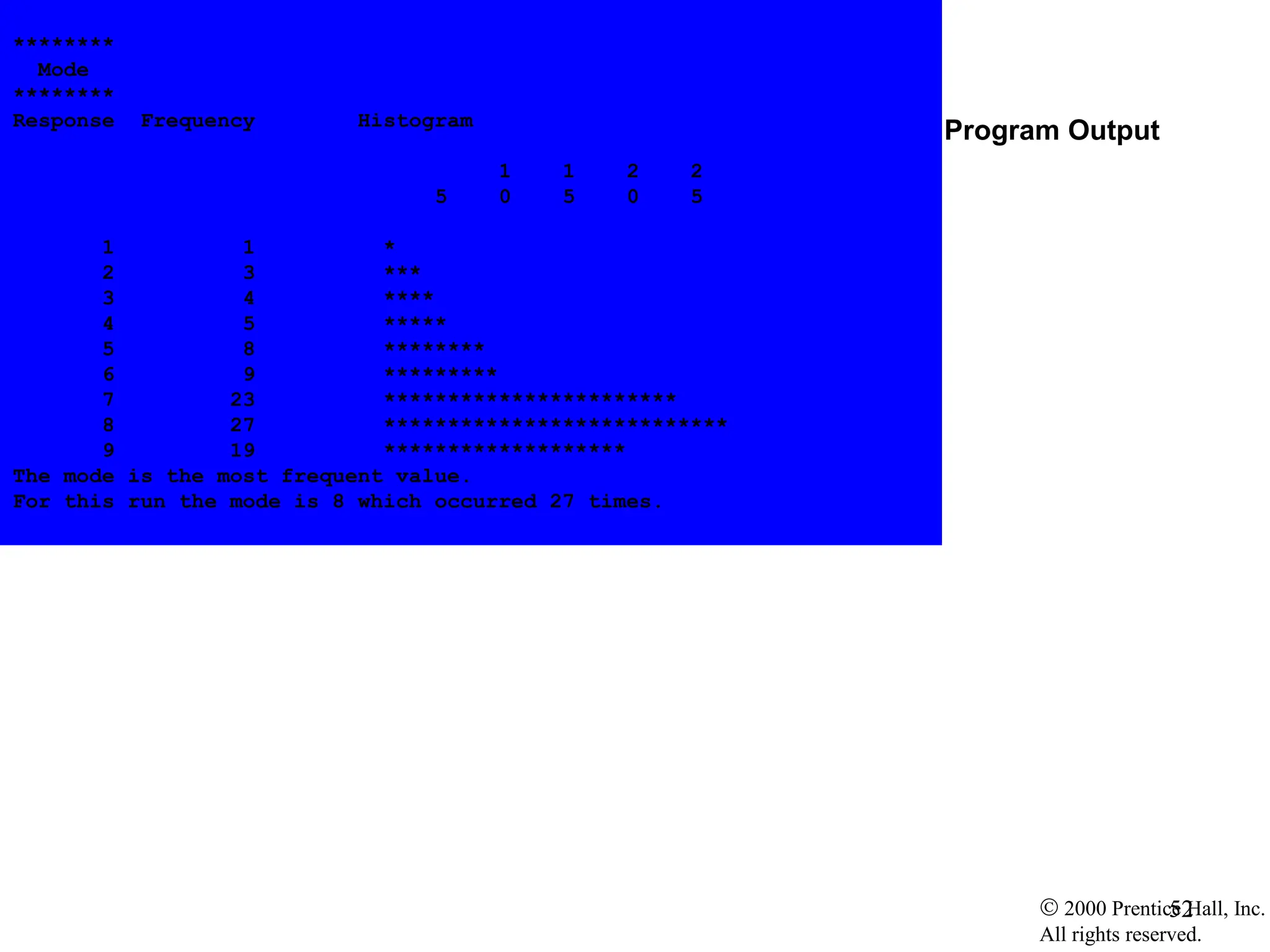
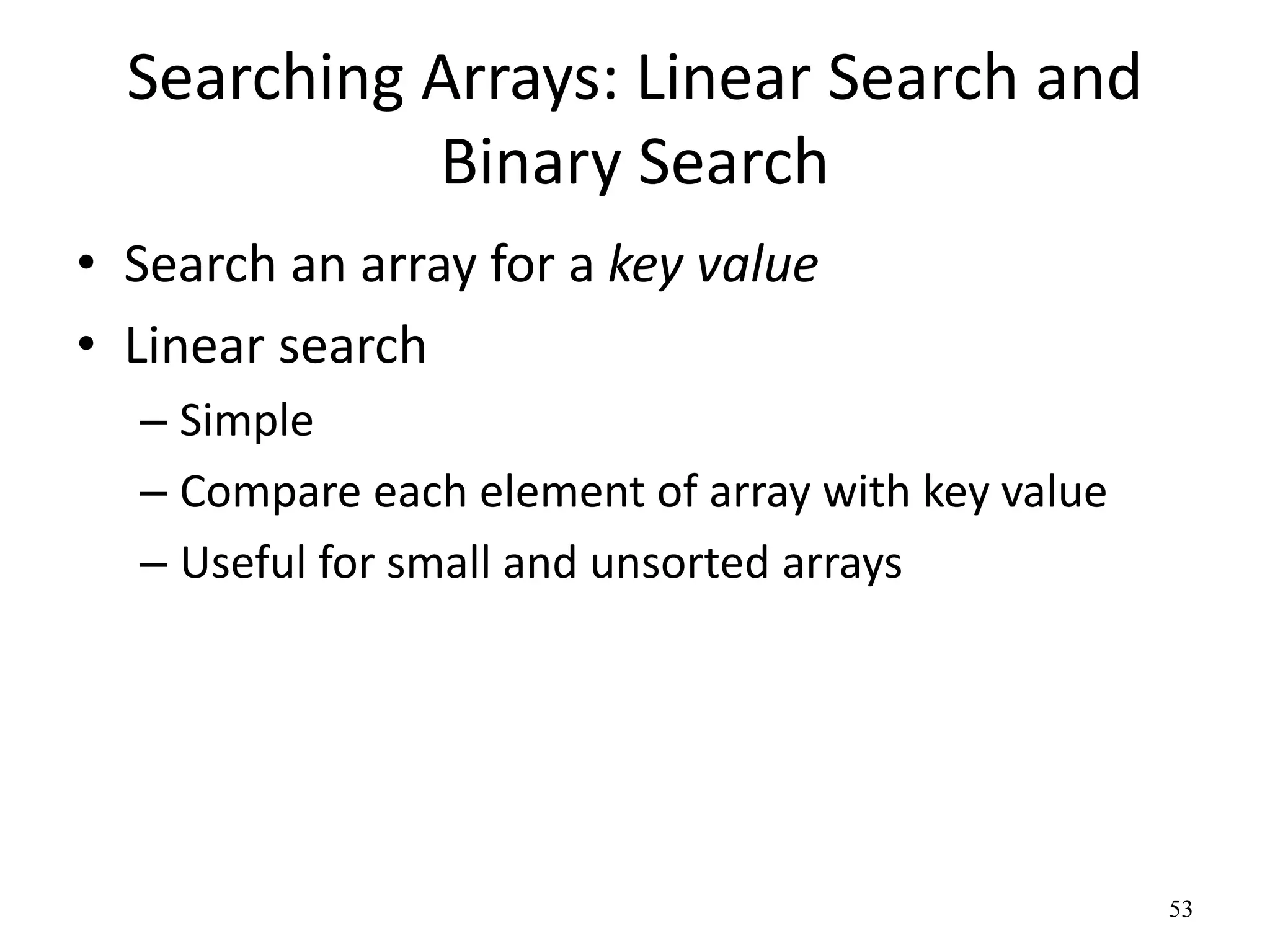
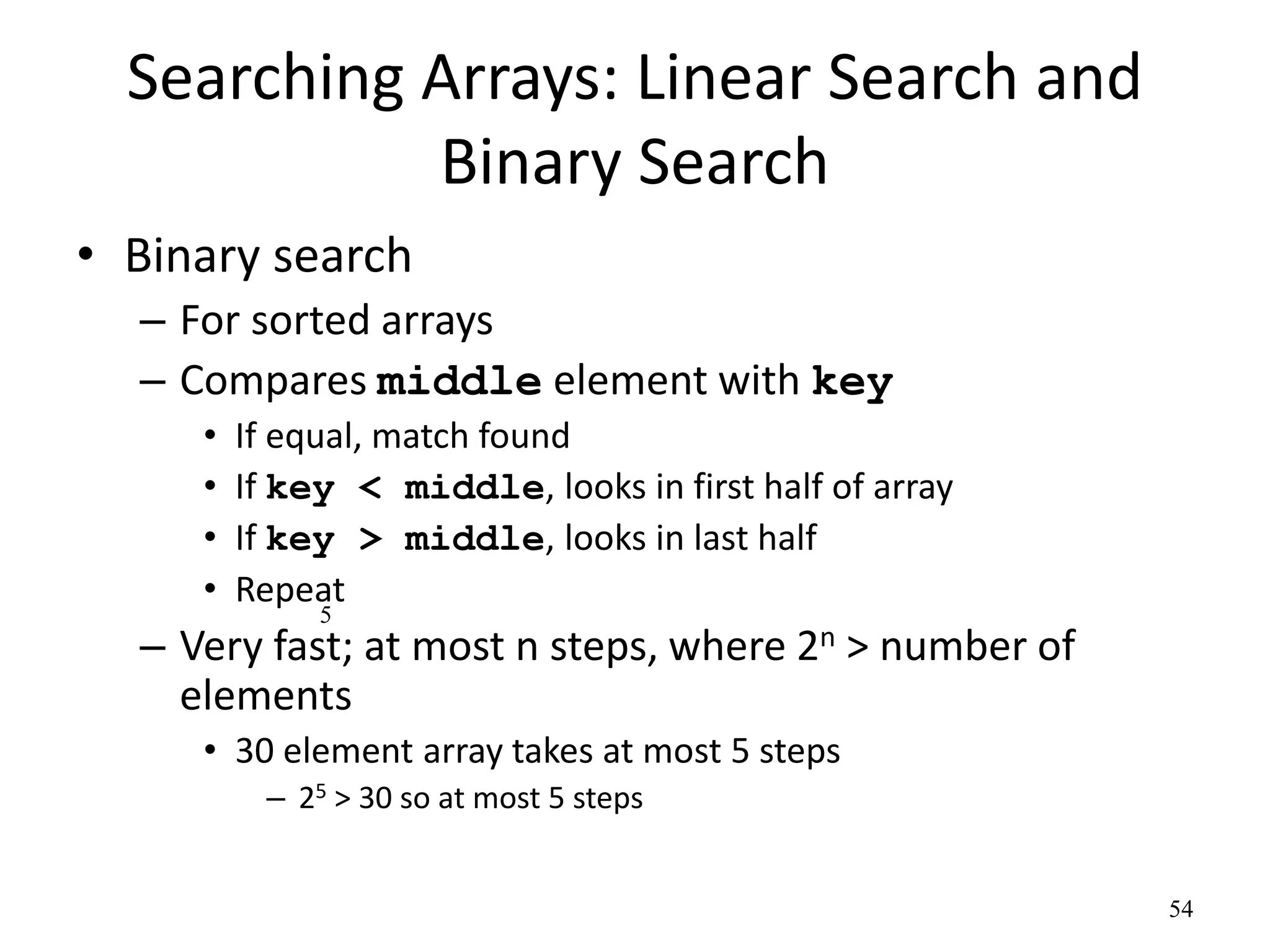
![Multiple-Subscripted Arrays • Multiple subscripted arrays – Tables with rows and columns (m by n array) – Like matrices: specify row, then column 55 Row 0 Row 1 Row 2 Column 0 Column 1 Column 2 Column 3 a[ 0 ][ 0 ] a[ 1 ][ 0 ] a[ 2 ][ 0 ] a[ 0 ][ 1 ] a[ 1 ][ 1 ] a[ 2 ][ 1 ] a[ 0 ][ 2 ] a[ 1 ][ 2 ] a[ 2 ][ 2 ] a[ 0 ][ 3 ] a[ 1 ][ 3 ] a[ 2 ][ 3 ] Row subscript Array name Column subscript](https://image.slidesharecdn.com/dsmodule-12023-240707035514-c76abc94/75/Basics-of-Data-structure-using-C-describing-basics-concepts-55-2048.jpg)
![Multiple-Subscripted Arrays • Initialization – int b[ 2 ][ 2 ] = { { 1, 2 }, { 3, 4 } }; – Initializers grouped by row in braces – If not enough, unspecified elements set to zero int b[ 2 ][ 2 ] = { { 1 }, { 3, 4 } }; • Referencing elements – Specify row, then column printf( "%d", b[ 0 ][ 1 ] ); 56 1 2 3 4 1 0 3 4](https://image.slidesharecdn.com/dsmodule-12023-240707035514-c76abc94/75/Basics-of-Data-structure-using-C-describing-basics-concepts-56-2048.jpg)
![ 2000 Prentice Hall, Inc. All rights reserved. 1. Initialize variables 1.1 Define functions to take double scripted arrays 1.2 Initialize studentgrades[][] 2. Call functions minimum, maximum, and average 1 /* 2 Double-subscripted array example */ 3 #include <stdio.h> 4 #define STUDENTS 3 5 #define EXAMS 4 6 7 int minimum( const int [][ EXAMS ], int, int ); 8 int maximum( const int [][ EXAMS ], int, int ); 9 double average( const int [], int ); 10 void printArray( const int [][ EXAMS ], int, int ); 11 12 int main() 13 { 14 int student; 15 const int studentGrades[ STUDENTS ][ EXAMS ] = 16 { { 77, 68, 86, 73 }, 17 { 96, 87, 89, 78 }, 18 { 70, 90, 86, 81 } }; 19 20 printf( "The array is:n" ); 21 printArray( studentGrades, STUDENTS, EXAMS ); 22 printf( "nnLowest grade: %dnHighest grade: %dn", 23 minimum( studentGrades, STUDENTS, EXAMS ), 24 maximum( studentGrades, STUDENTS, EXAMS ) ); 25 26 for ( student = 0; student <= STUDENTS - 1; student++ ) 27 printf( "The average grade for student %d is %.2fn", 28 student, 29 average( studentGrades[ student ], EXAMS ) ); 30 31 return 0; 32 } Each row is a particular student, each column is the grades on the exam.](https://image.slidesharecdn.com/dsmodule-12023-240707035514-c76abc94/75/Basics-of-Data-structure-using-C-describing-basics-concepts-57-2048.jpg)
![ 2000 Prentice Hall, Inc. All rights reserved. 3. Define functions 33 34 /* Find the minimum grade */ 35 int minimum( const int grades[][ EXAMS ], 36 int pupils, int tests ) 37 { 38 int i, j, lowGrade = 100; 39 40 for ( i = 0; i <= pupils - 1; i++ ) 41 for ( j = 0; j <= tests - 1; j++ ) 42 if ( grades[ i ][ j ] < lowGrade ) 43 lowGrade = grades[ i ][ j ]; 44 45 return lowGrade; 46 } 47 48 /* Find the maximum grade */ 49 int maximum( const int grades[][ EXAMS ], 50 int pupils, int tests ) 51 { 52 int i, j, highGrade = 0; 53 54 for ( i = 0; i <= pupils - 1; i++ ) 55 for ( j = 0; j <= tests - 1; j++ ) 56 if ( grades[ i ][ j ] > highGrade ) 57 highGrade = grades[ i ][ j ]; 58 59 return highGrade; 60 } 61 62 /* Determine the average grade for a particular exam */ 63 double average( const int setOfGrades[], int tests ) 64 {](https://image.slidesharecdn.com/dsmodule-12023-240707035514-c76abc94/75/Basics-of-Data-structure-using-C-describing-basics-concepts-58-2048.jpg)
![ 2000 Prentice Hall, Inc. All rights reserved. 3. Define functions 65 int i, total = 0; 66 67 for ( i = 0; i <= tests - 1; i++ ) 68 total += setOfGrades[ i ]; 69 70 return ( double ) total / tests; 71 } 72 73 /* Print the array */ 74 void printArray( const int grades[][ EXAMS ], 75 int pupils, int tests ) 76 { 77 int i, j; 78 79 printf( " [0] [1] [2] [3]" ); 80 81 for ( i = 0; i <= pupils - 1; i++ ) { 82 printf( "nstudentGrades[%d] ", i ); 83 84 for ( j = 0; j <= tests - 1; j++ ) 85 printf( "%-5d", grades[ i ][ j ] ); 86 } 87 }](https://image.slidesharecdn.com/dsmodule-12023-240707035514-c76abc94/75/Basics-of-Data-structure-using-C-describing-basics-concepts-59-2048.jpg)
![ 2000 Prentice Hall, Inc. All rights reserved. Program Output 60 The array is: [0] [1] [2] [3] studentGrades[0] 77 68 86 73 studentGrades[1] 96 87 89 78 studentGrades[2] 70 90 86 81 Lowest grade: 68 Highest grade: 96 The average grade for student 0 is 76.00 The average grade for student 1 is 87.50 The average grade for student 2 is 81.75](https://image.slidesharecdn.com/dsmodule-12023-240707035514-c76abc94/75/Basics-of-Data-structure-using-C-describing-basics-concepts-60-2048.jpg)
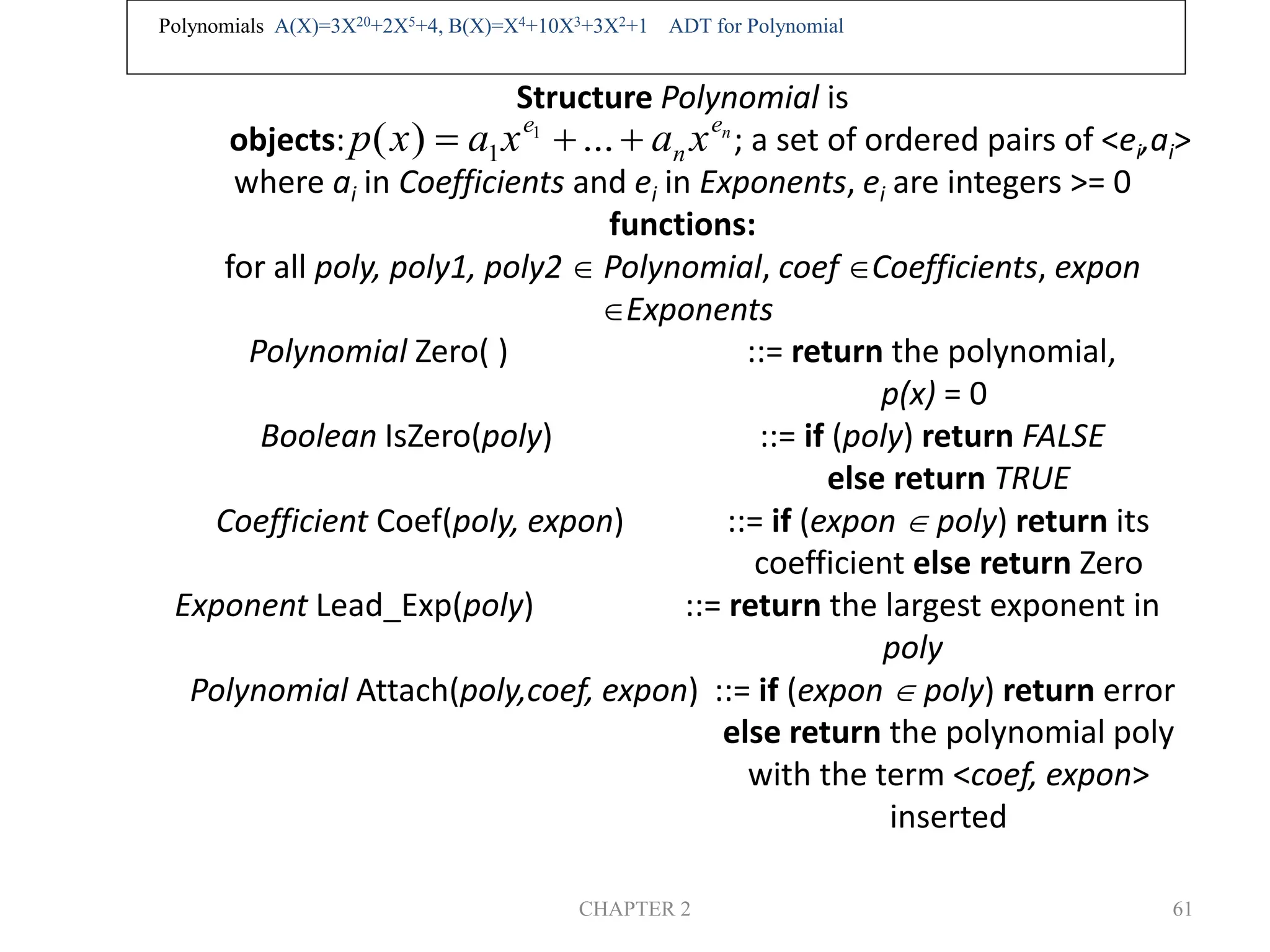
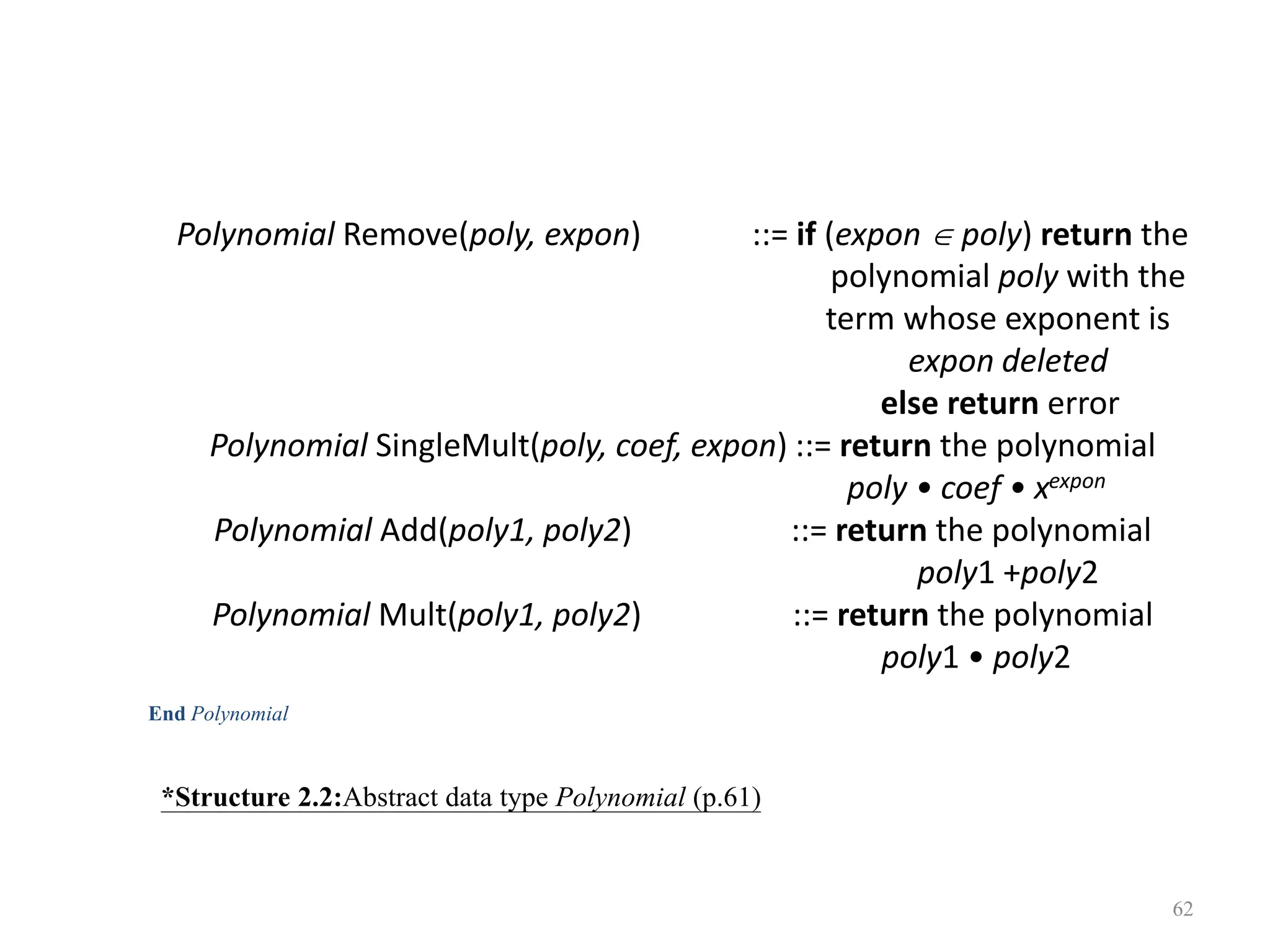
![63 /* d =a + b, where a, b, and d are polynomials */ d = Zero( ) while (! IsZero(a) && ! IsZero(b)) do { switch COMPARE (Lead_Exp(a), Lead_Exp(b)) { case -1: d = Attach(d, Coef (b, Lead_Exp(b)), Lead_Exp(b)); b = Remove(b, Lead_Exp(b)); break; case 0: sum = Coef (a, Lead_Exp (a)) + Coef ( b, Lead_Exp(b)); if (sum) { Attach (d, sum, Lead_Exp(a)); a = Remove(a , Lead_Exp(a)); b = Remove(b , Lead_Exp(b)); } break; Polynomial Addition #define MAX_DEGREE 101 typedef struct { int degree; float coef[MAX_DEGREE]; } polynomial; data structure 1:](https://image.slidesharecdn.com/dsmodule-12023-240707035514-c76abc94/75/Basics-of-Data-structure-using-C-describing-basics-concepts-63-2048.jpg)
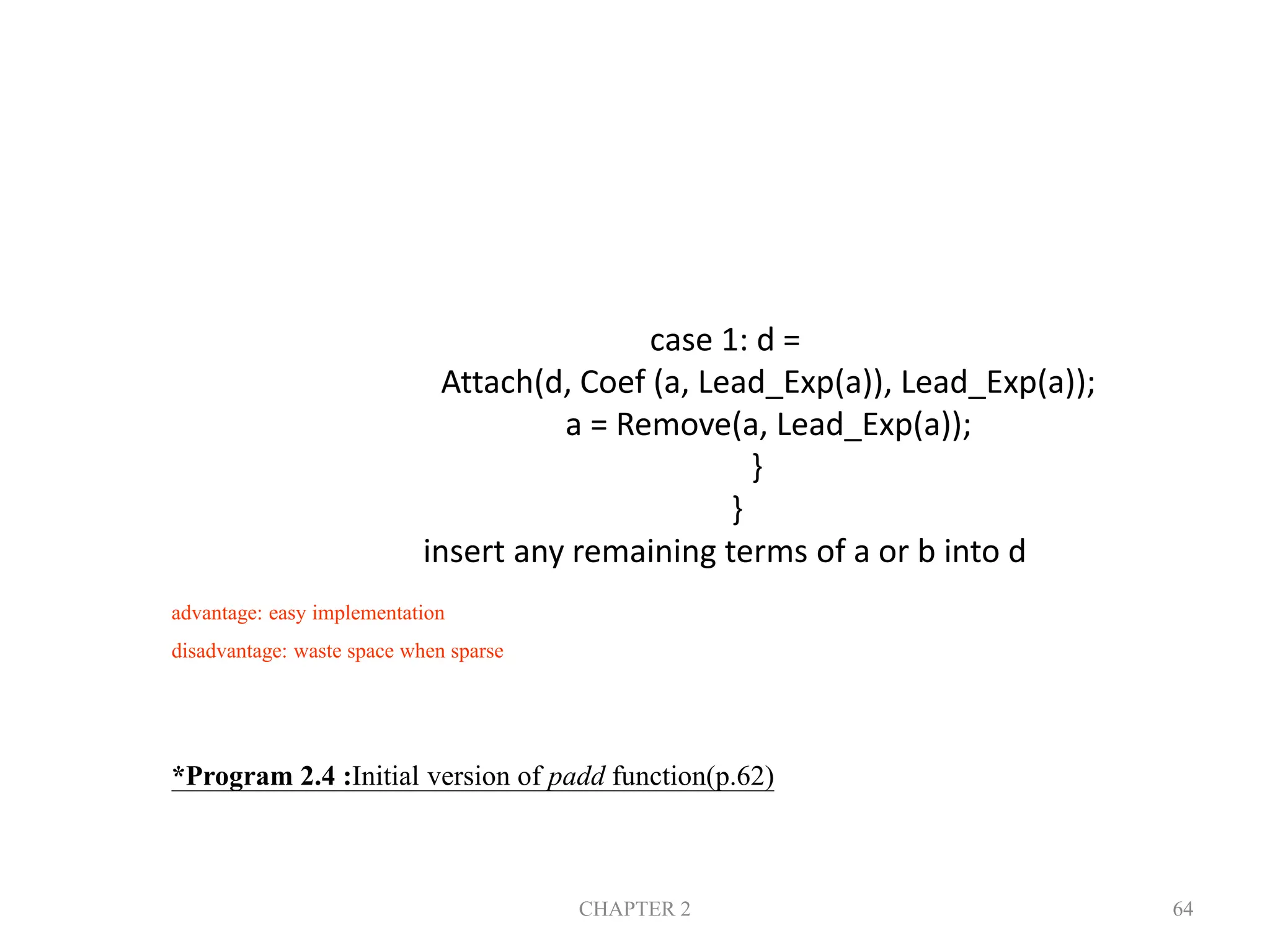
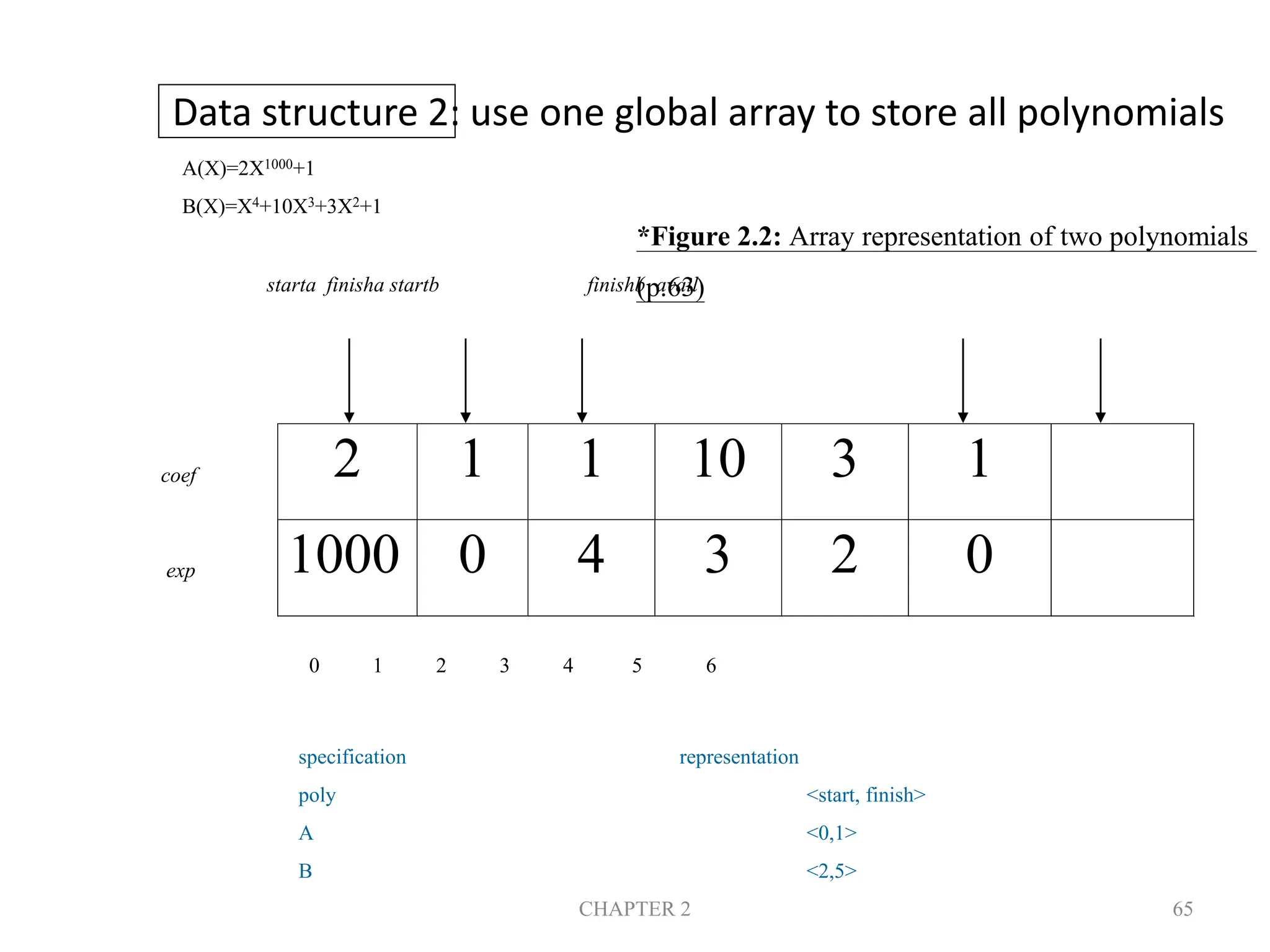
![CHAPTER 2 66 MAX_TERMS 100 /* size of terms array */ typedef struct { float coef; int expon; } polynomial; polynomial terms[MAX_TERMS]; int avail = 0; *(p.62) storage requirements: start, finish, 2*(finish-start+1) nonparse: twice as much as (1) when all the items are nonzero](https://image.slidesharecdn.com/dsmodule-12023-240707035514-c76abc94/75/Basics-of-Data-structure-using-C-describing-basics-concepts-66-2048.jpg)
![CHAPTER 2 67 void padd (int starta, int finisha, int startb, int finishb, int * startd, int *finishd) { /* add A(x) and B(x) to obtain D(x) */ float coefficient; *startd = avail; while (starta <= finisha && startb <= finishb) switch (COMPARE(terms[starta].expon, terms[startb].expon)) { case -1: /* a expon < b expon */ attach(terms[startb].coef, terms[startb].expon); startb++ break; Add two polynomials: D = A + B](https://image.slidesharecdn.com/dsmodule-12023-240707035514-c76abc94/75/Basics-of-Data-structure-using-C-describing-basics-concepts-67-2048.jpg)
![CHAPTER 2 68 case 0: /* equal exponents */ coefficient = terms[starta].coef + terms[startb].coef; if (coefficient) attach (coefficient, terms[starta].expon); starta++; startb++; break; case 1: /* a expon > b expon */ attach(terms[starta].coef, terms[starta].expon); starta++; }](https://image.slidesharecdn.com/dsmodule-12023-240707035514-c76abc94/75/Basics-of-Data-structure-using-C-describing-basics-concepts-68-2048.jpg)
![CHAPTER 2 69 /* add in remaining terms of A(x) */ for( ; starta <= finisha; starta++) attach(terms[starta].coef, terms[starta].expon); /* add in remaining terms of B(x) */ for( ; startb <= finishb; startb++) attach(terms[startb].coef, terms[startb].expon); *finishd =avail -1; } *Program 2.5: Function to add two polynomial (p.64) Analysis: O(n+m) where n (m) is the number of nonzeros in A(B).](https://image.slidesharecdn.com/dsmodule-12023-240707035514-c76abc94/75/Basics-of-Data-structure-using-C-describing-basics-concepts-69-2048.jpg)
![CHAPTER 2 70 void attach(float coefficient, int exponent) { /* add a new term to the polynomial */ if (avail >= MAX_TERMS) { fprintf(stderr, “Too many terms in the polynomialn”); exit(1); } terms[avail].coef = coefficient; terms[avail++].expon = exponent; } *Program 2.6:Function to add anew term (p.65) Problem: Compaction is required when polynomials that are no longer needed. (data movement takes time.)](https://image.slidesharecdn.com/dsmodule-12023-240707035514-c76abc94/75/Basics-of-Data-structure-using-C-describing-basics-concepts-70-2048.jpg)
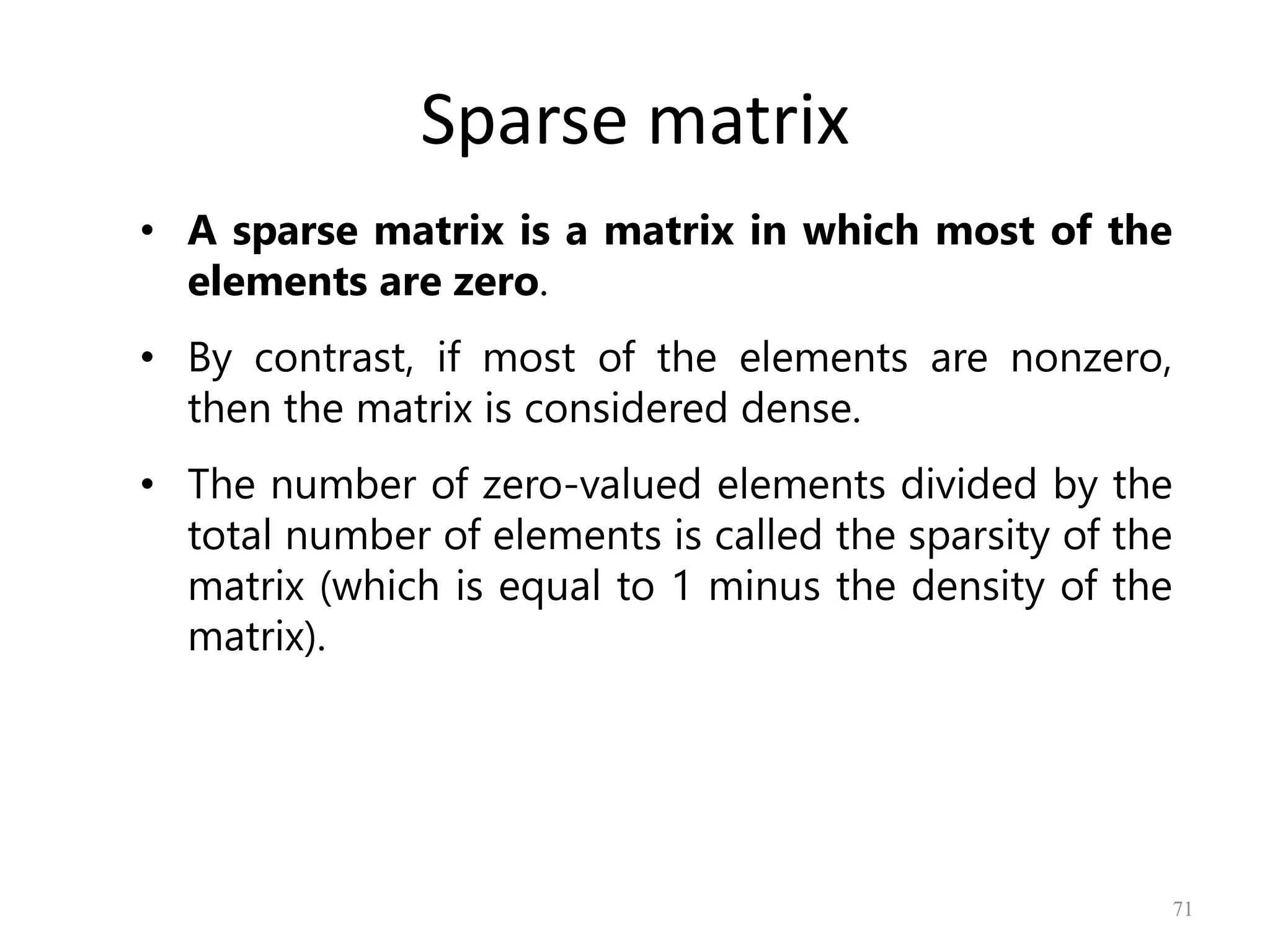
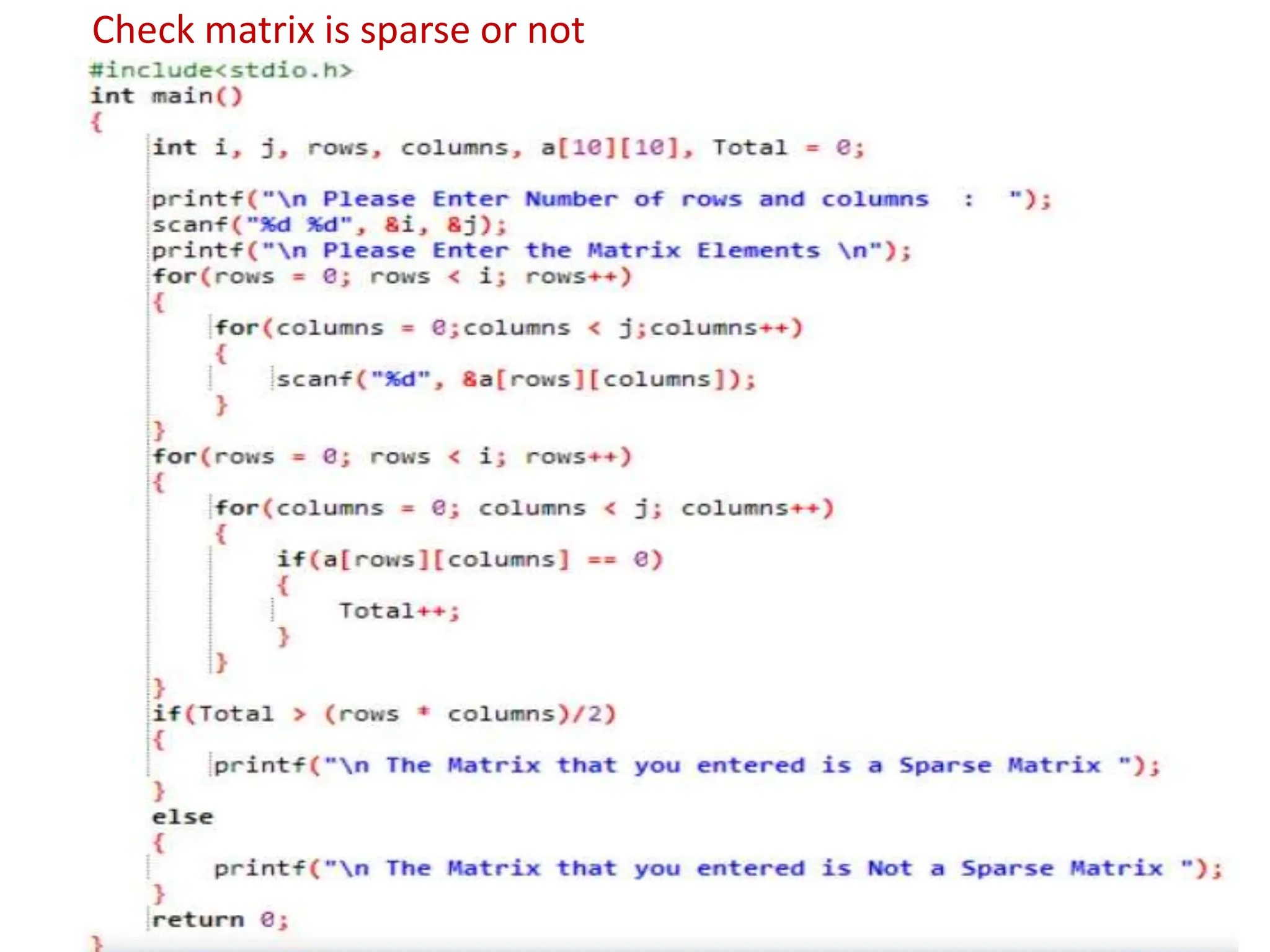
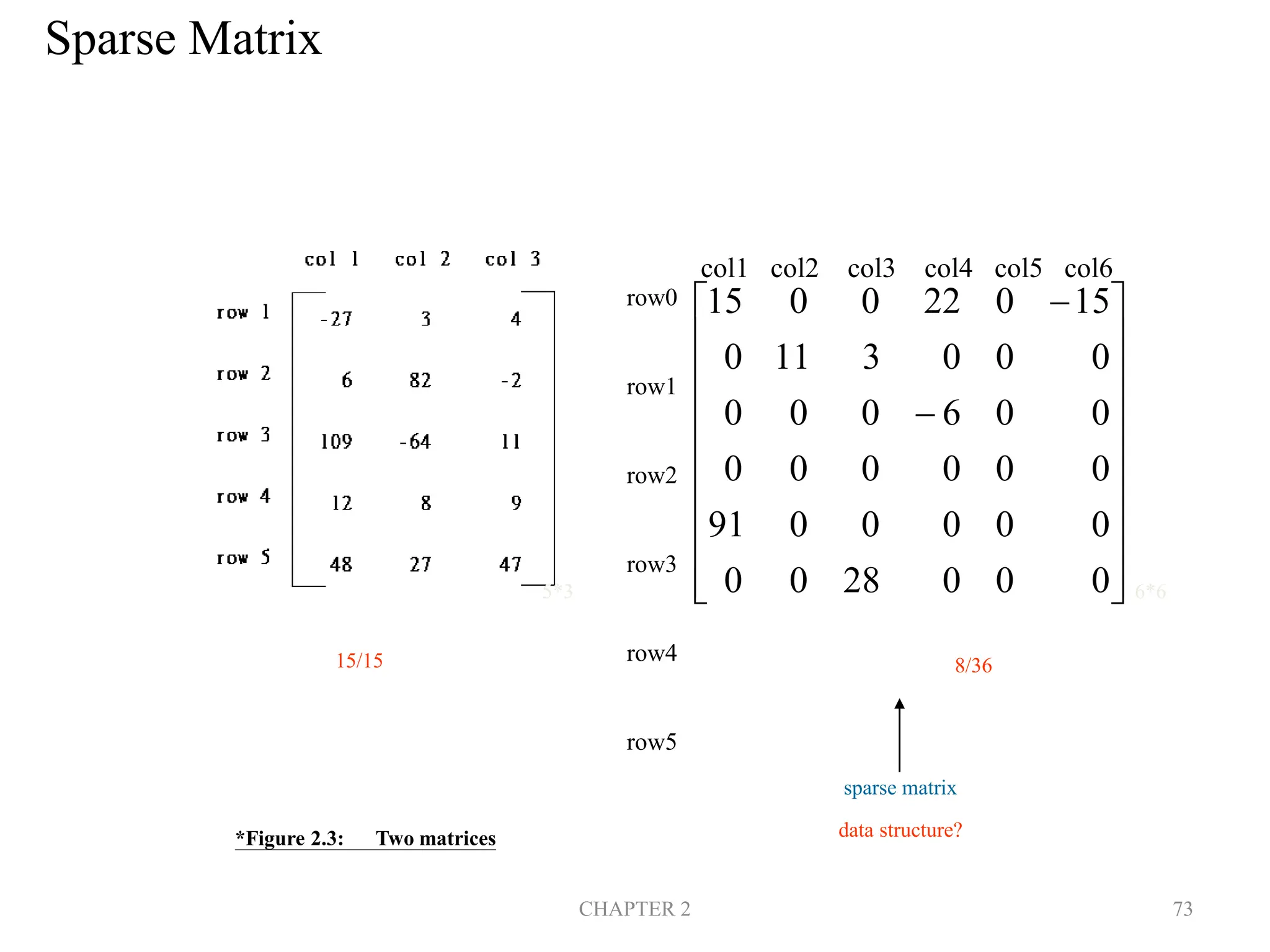
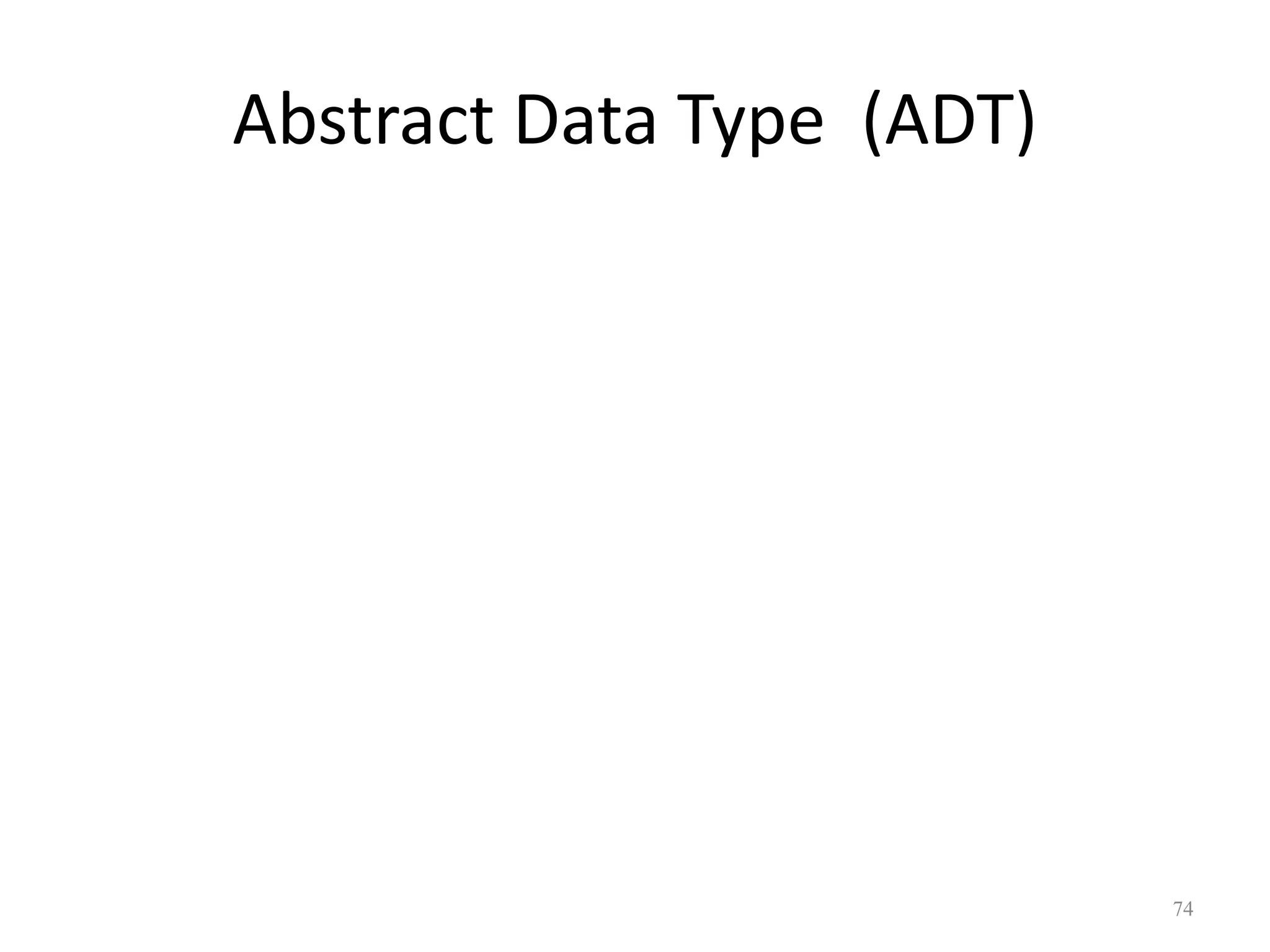
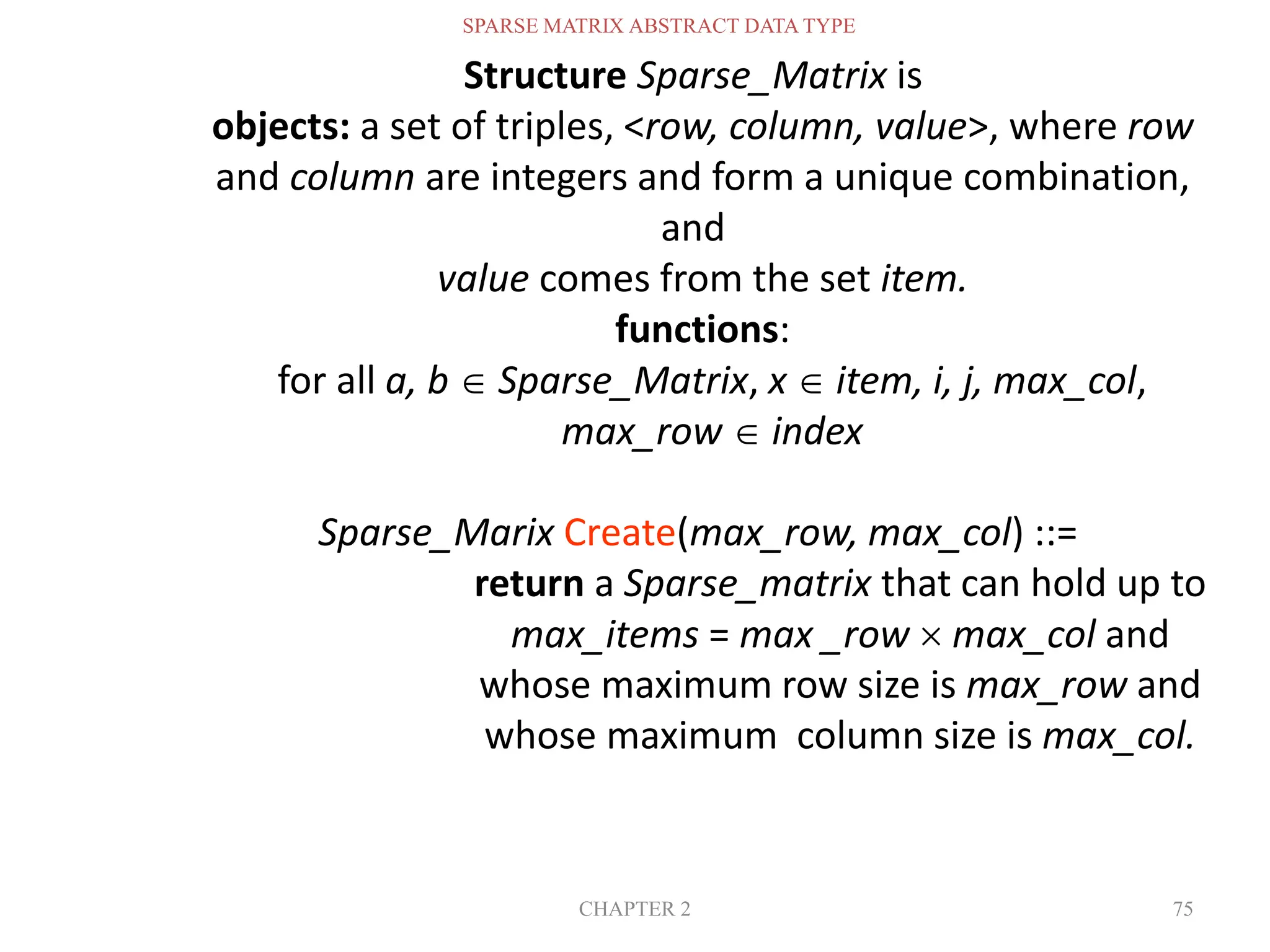
![CHAPTER 2 76 Sparse_Matrix Transpose(a) ::= return the matrix produced by interchanging the row and column value of every triple. Sparse_Matrix Add(a, b) ::= if the dimensions of a and b are the same return the matrix produced by adding corresponding items, namely those with identical row and column values. else return error Sparse_Matrix Multiply(a, b) ::= if number of columns in a equals number of rows in b return the matrix d produced by multiplying a by b according to the formula: d [i] [j] = (a[i][k]•b[k][j]) where d (i, j) is the (i,j)th element else return error. * Structure 2.3: Abstract data type Sparse-Matrix (p.68)](https://image.slidesharecdn.com/dsmodule-12023-240707035514-c76abc94/75/Basics-of-Data-structure-using-C-describing-basics-concepts-76-2048.jpg)
![CHAPTER 2 77 row col value row col value a[0] 6 6 8 b[0] 6 6 8 [1] 0 0 15 [1] 0 0 15 [2] 0 3 22 [2] 0 4 91 [3] 0 5 -15 [3] 1 1 11 [4] 1 1 11 [4] 2 1 3 [5] 1 2 3 [5] 2 5 28 [6] 2 3 -6 [6] 3 0 22 [7] 4 0 91 [7] 3 2 -6 [8] 5 2 28 [8] 5 0 -15 (a) (b) *Figure 2.4:Sparse matrix and its transpose stored as triples (p.69) (1) Represented by a two-dimensional array. Sparse matrix wastes space. (2) Each element is characterized by <row, col, value>. row, column in ascending order # of rows (columns) # of nonzero terms transpose](https://image.slidesharecdn.com/dsmodule-12023-240707035514-c76abc94/75/Basics-of-Data-structure-using-C-describing-basics-concepts-77-2048.jpg)
![CHAPTER 2 78 Sparse_matrix Create(max_row, max_col) ::= #define MAX_TERMS 101 /* maximum number of terms +1*/ typedef struct { int col; int row; int value; } term; term a[MAX_TERMS] * (P.69) # of rows (columns) # of nonzero terms](https://image.slidesharecdn.com/dsmodule-12023-240707035514-c76abc94/75/Basics-of-Data-structure-using-C-describing-basics-concepts-78-2048.jpg)